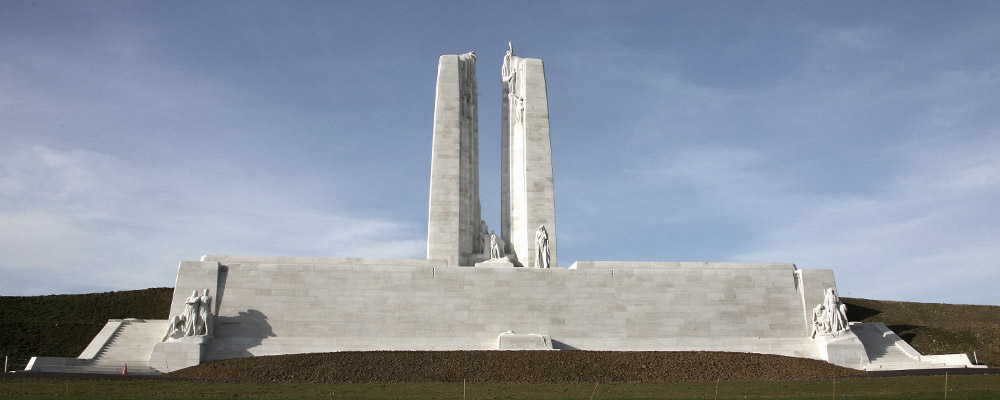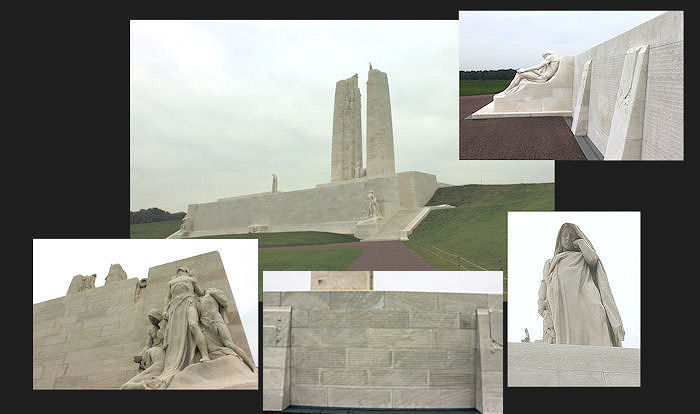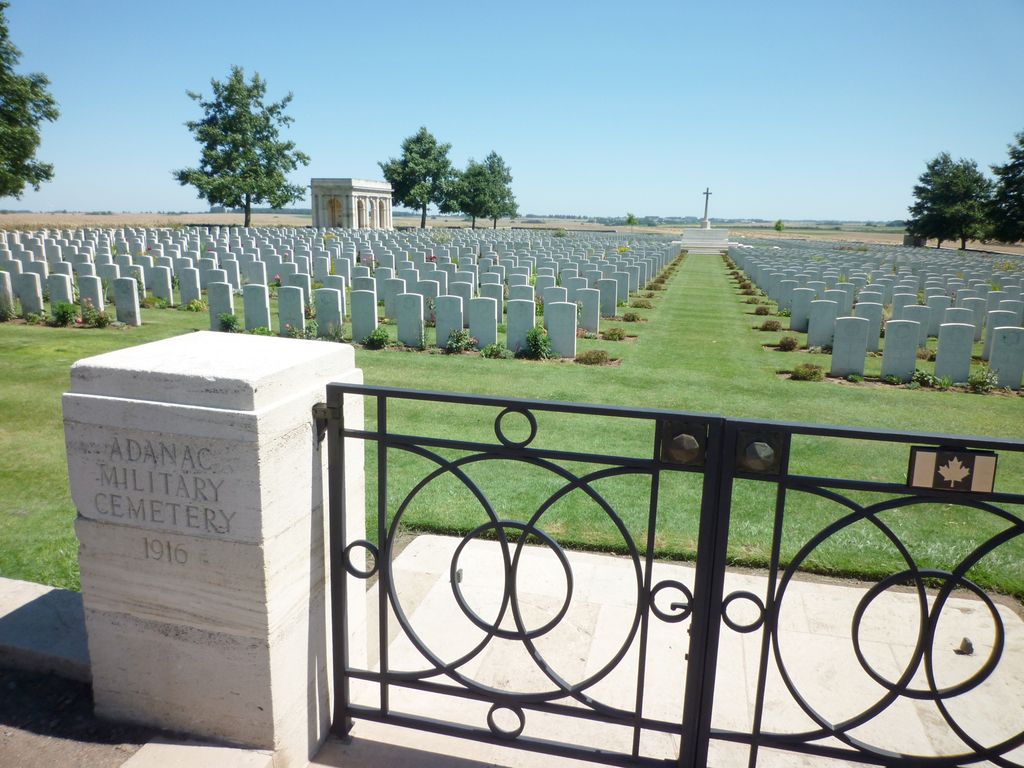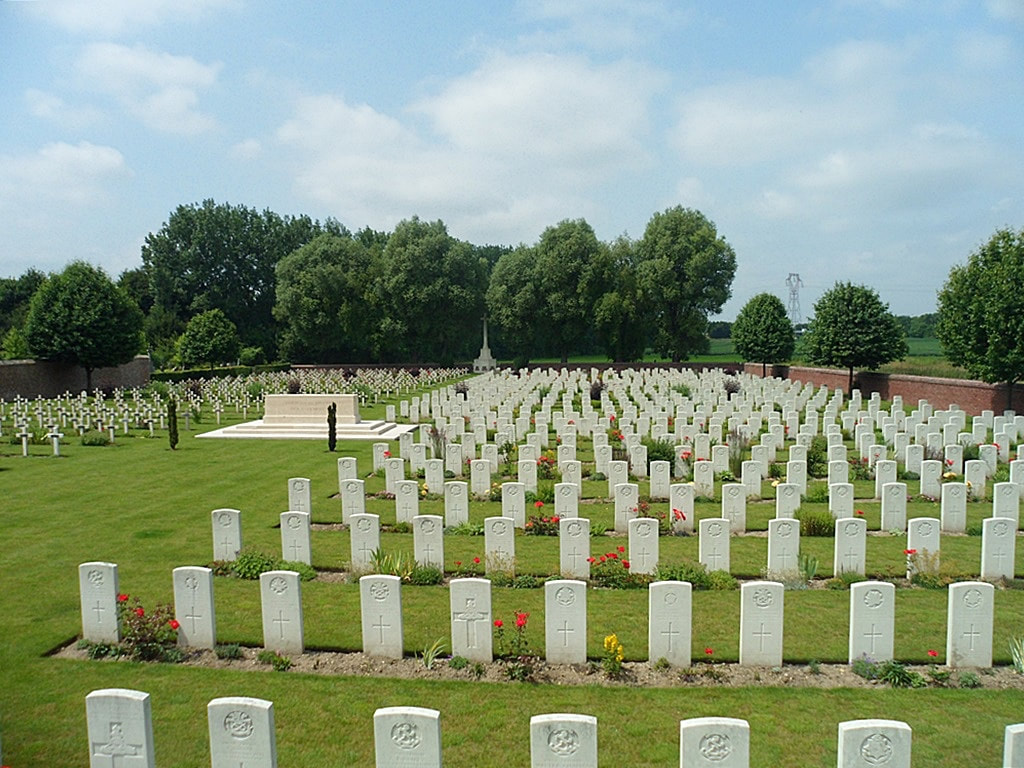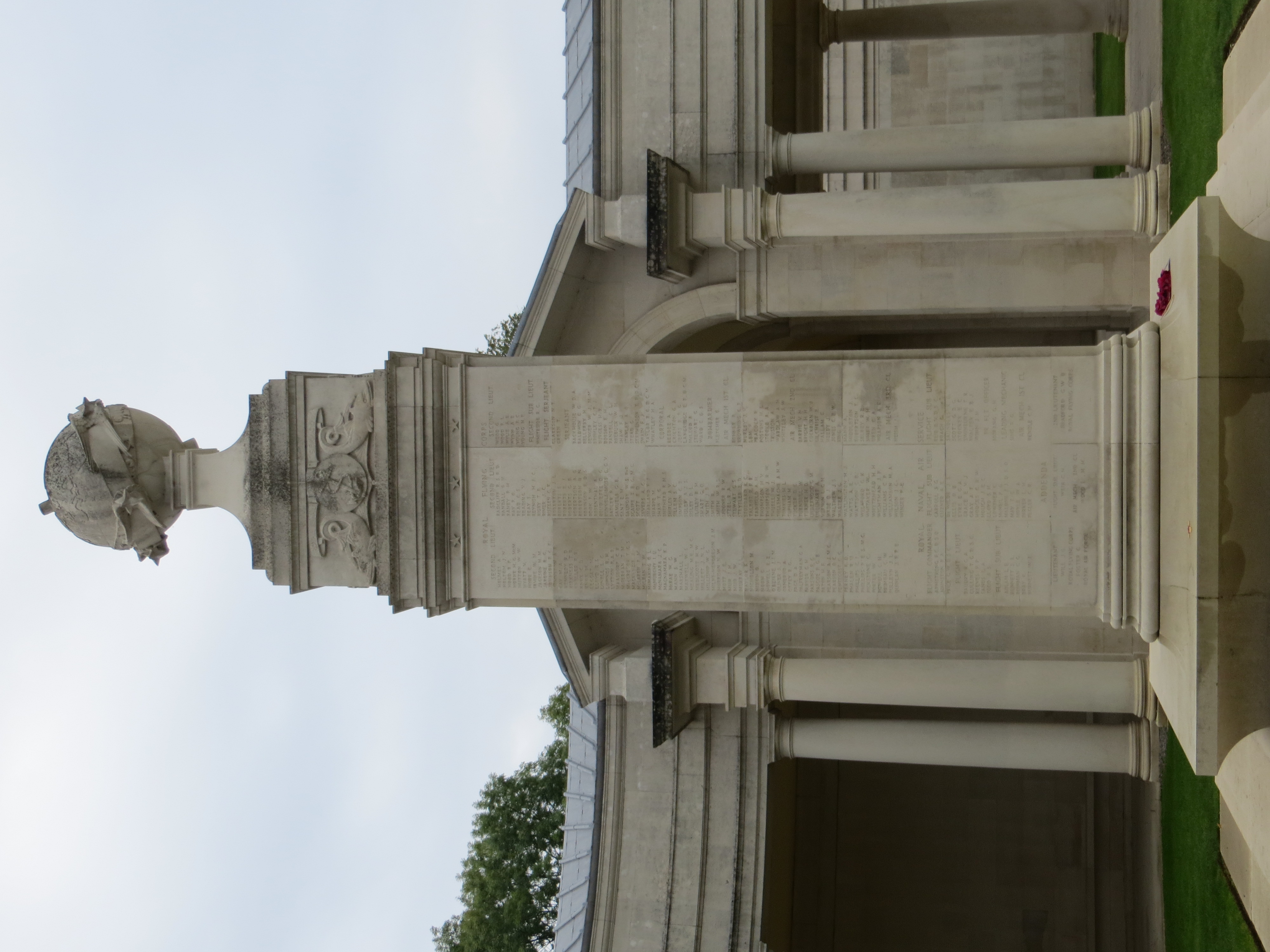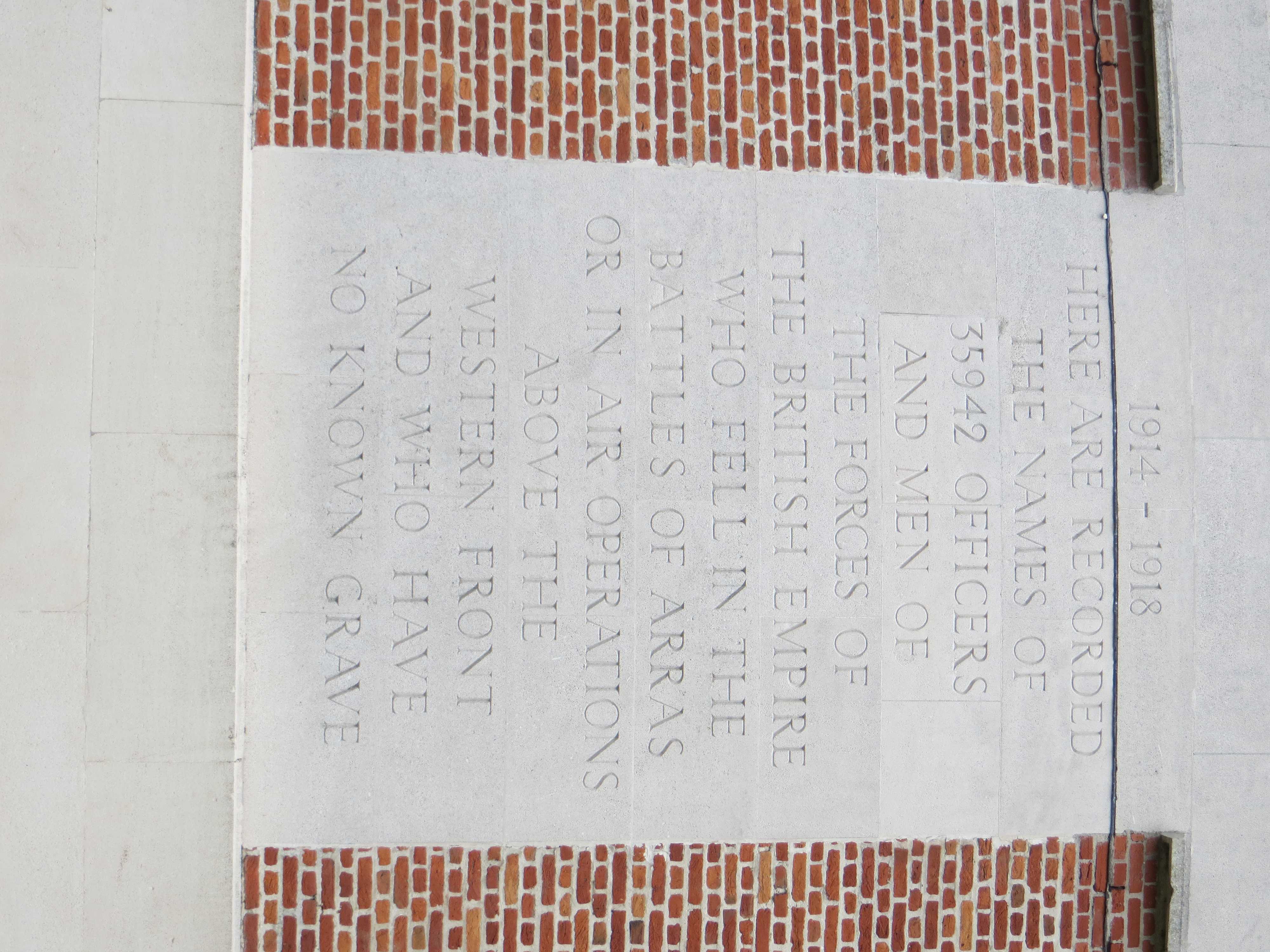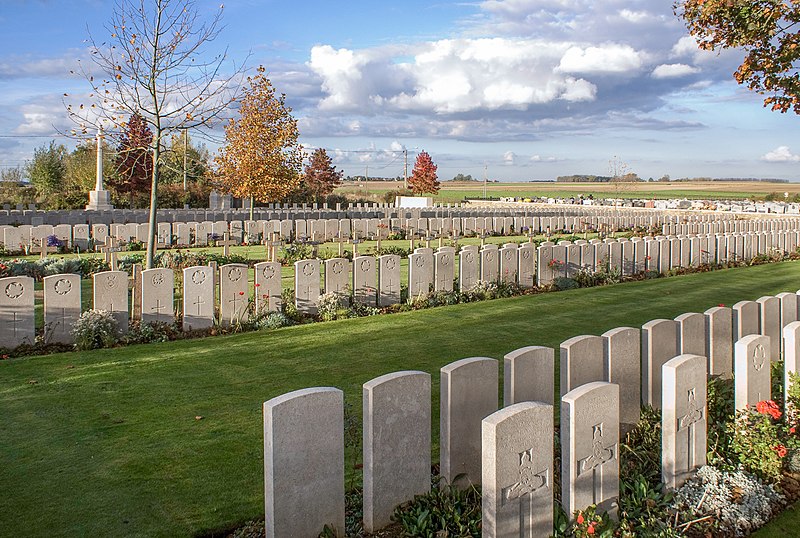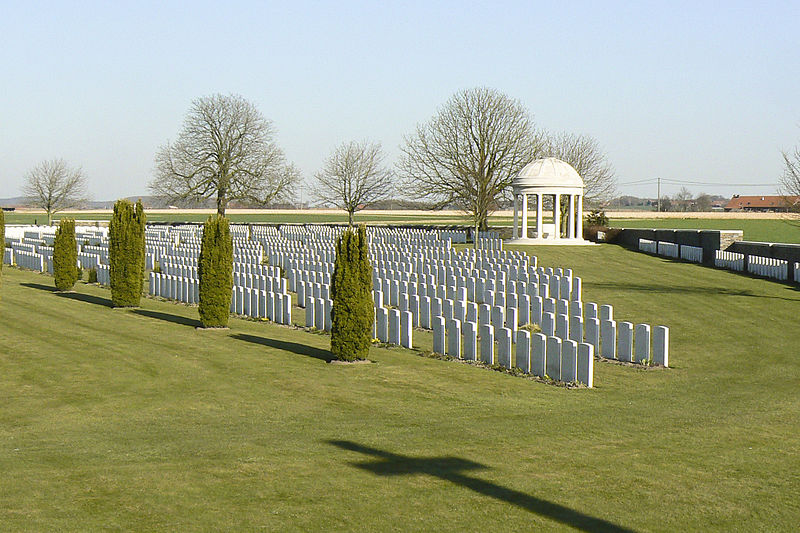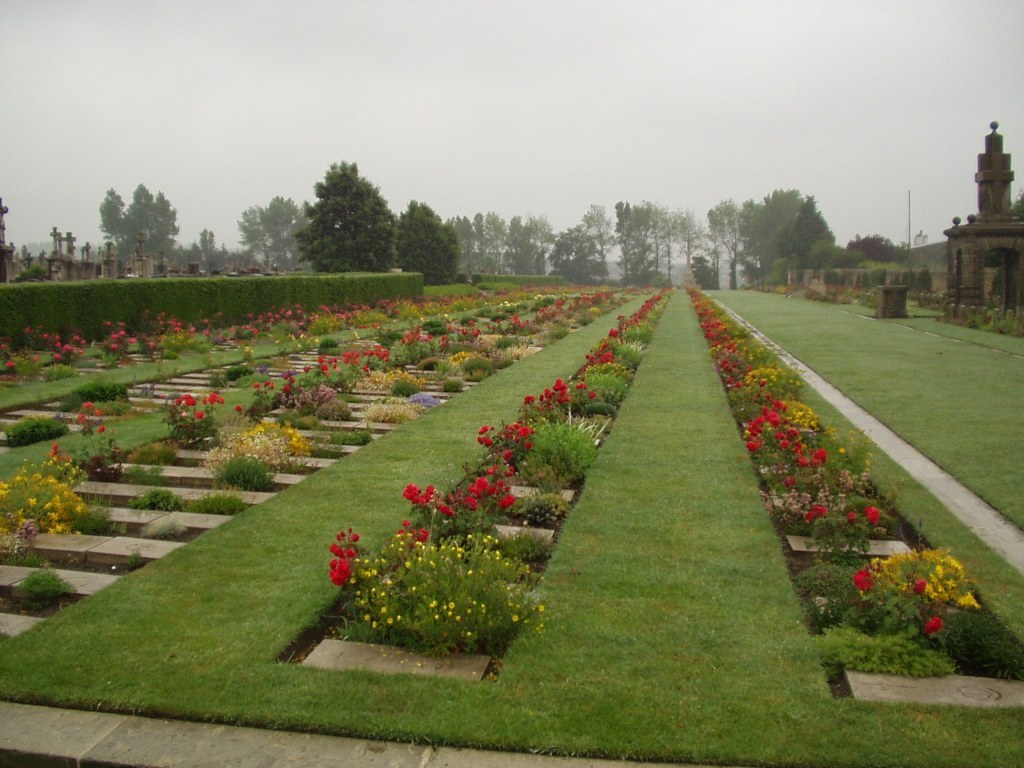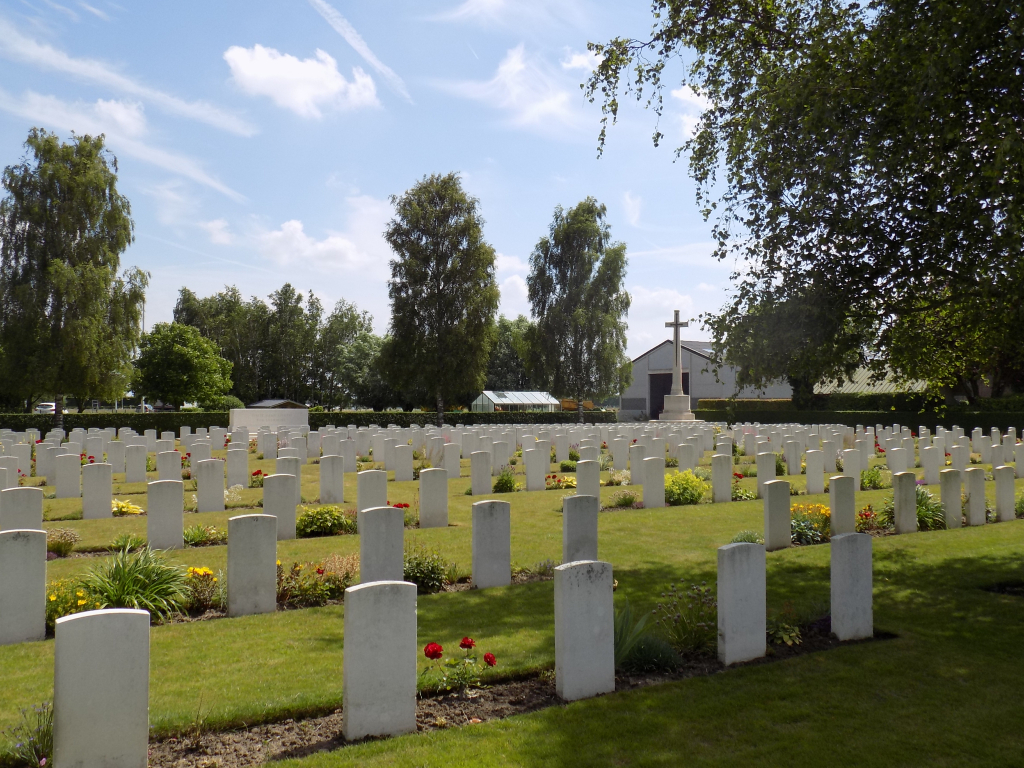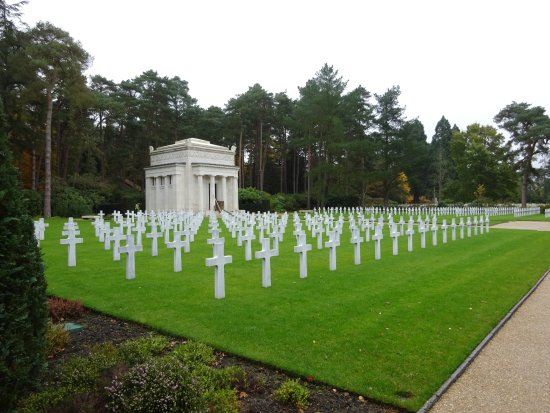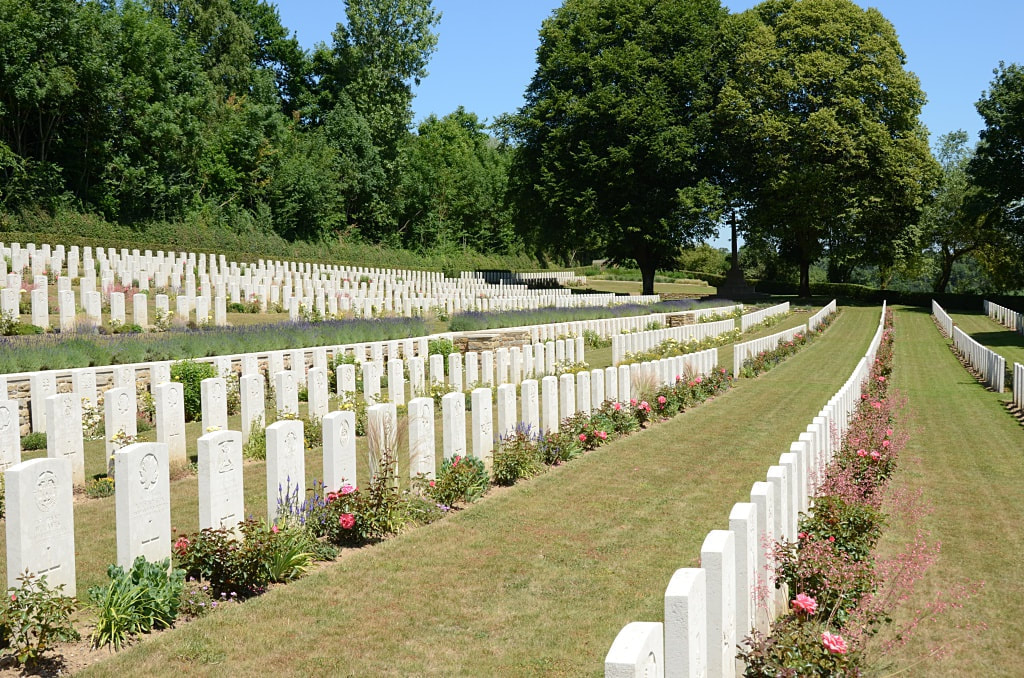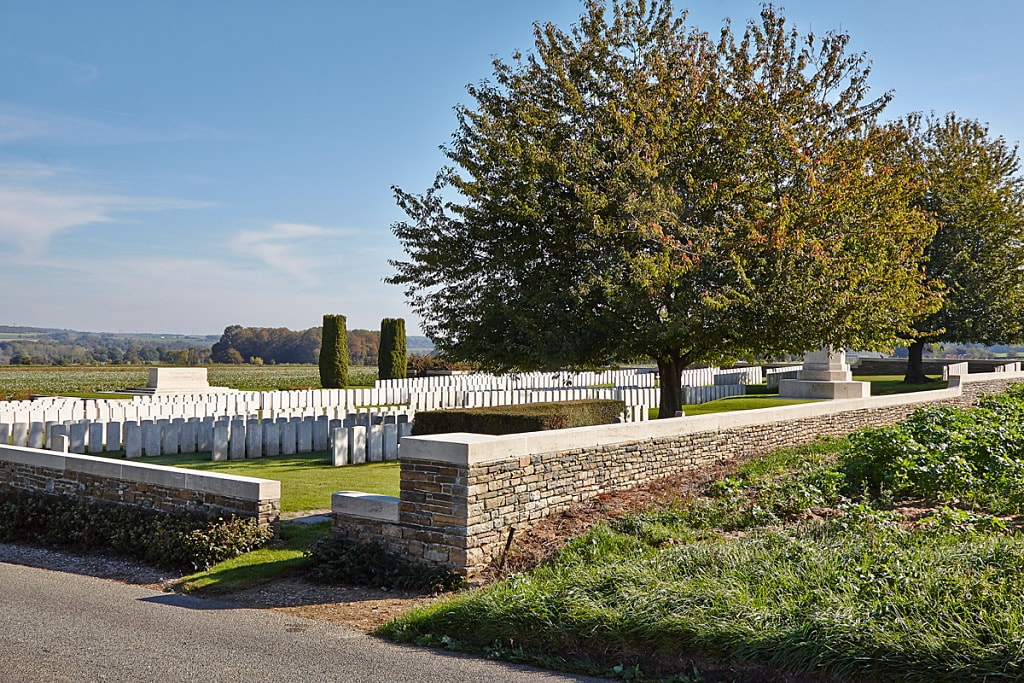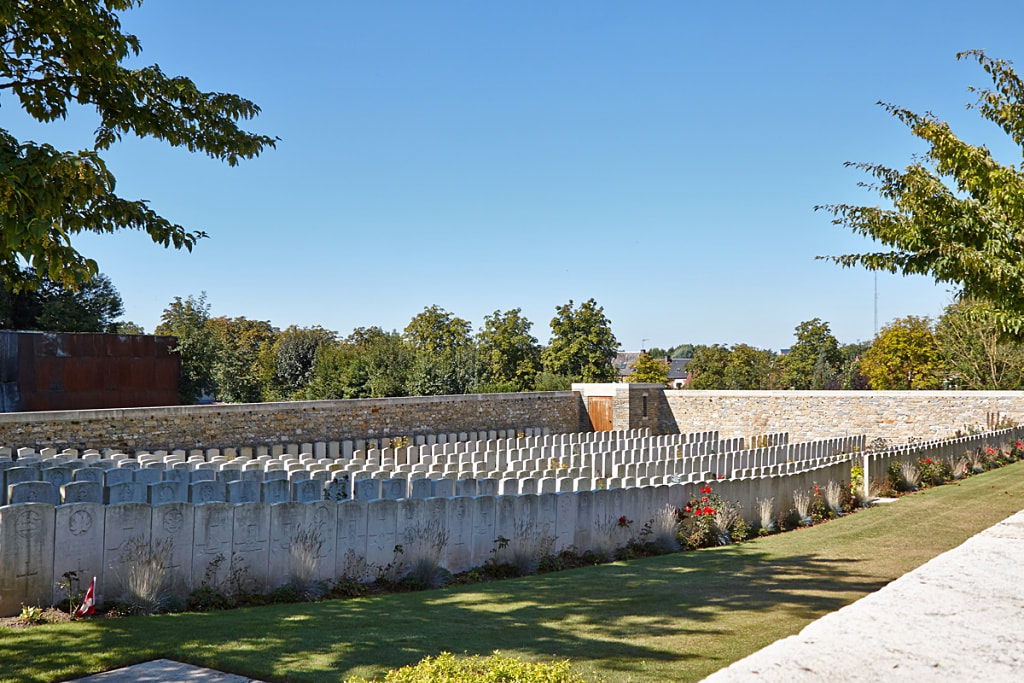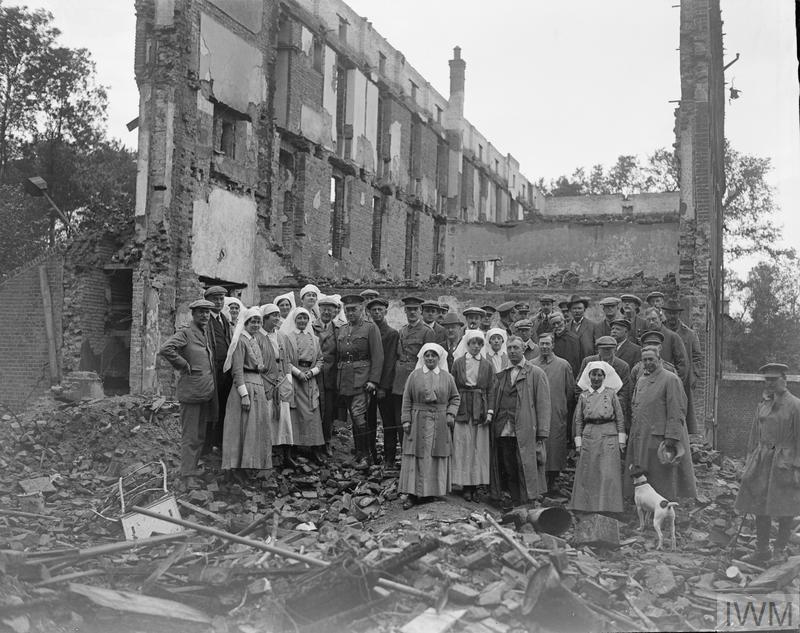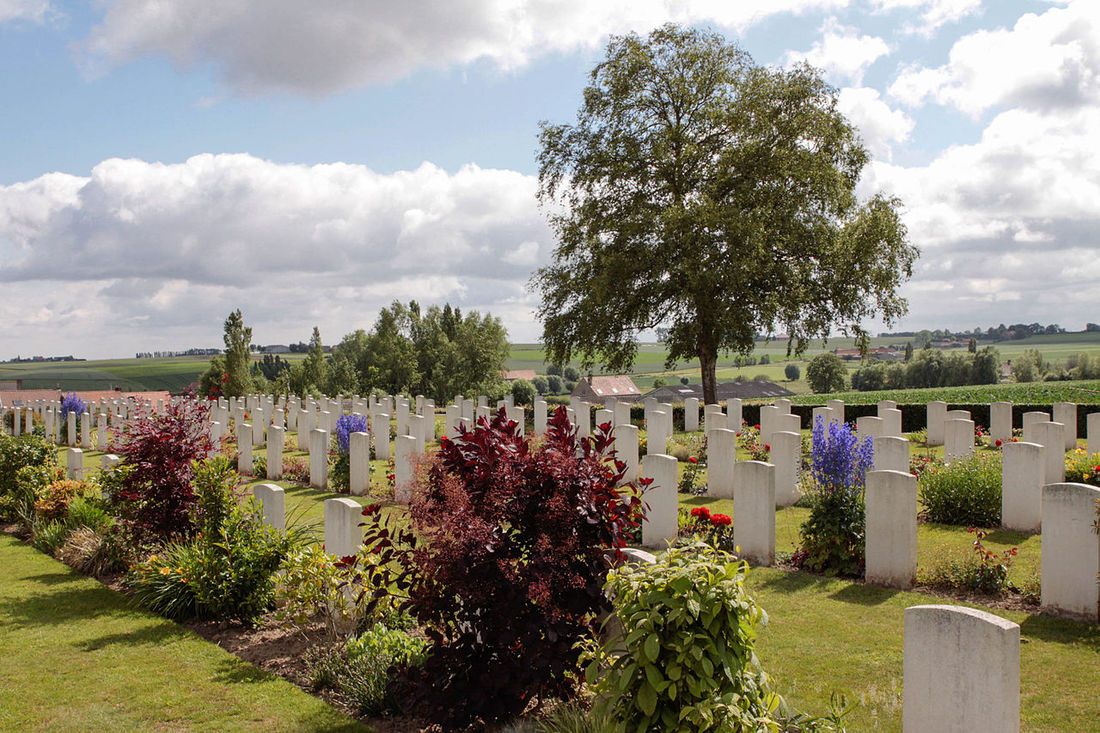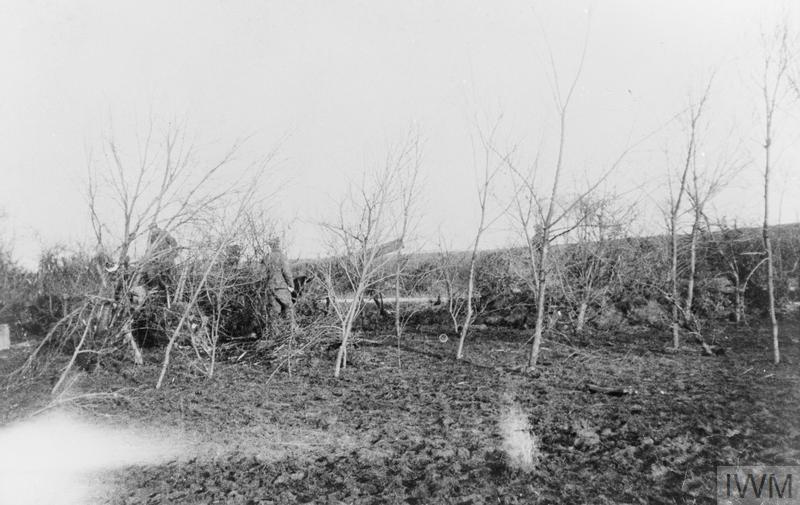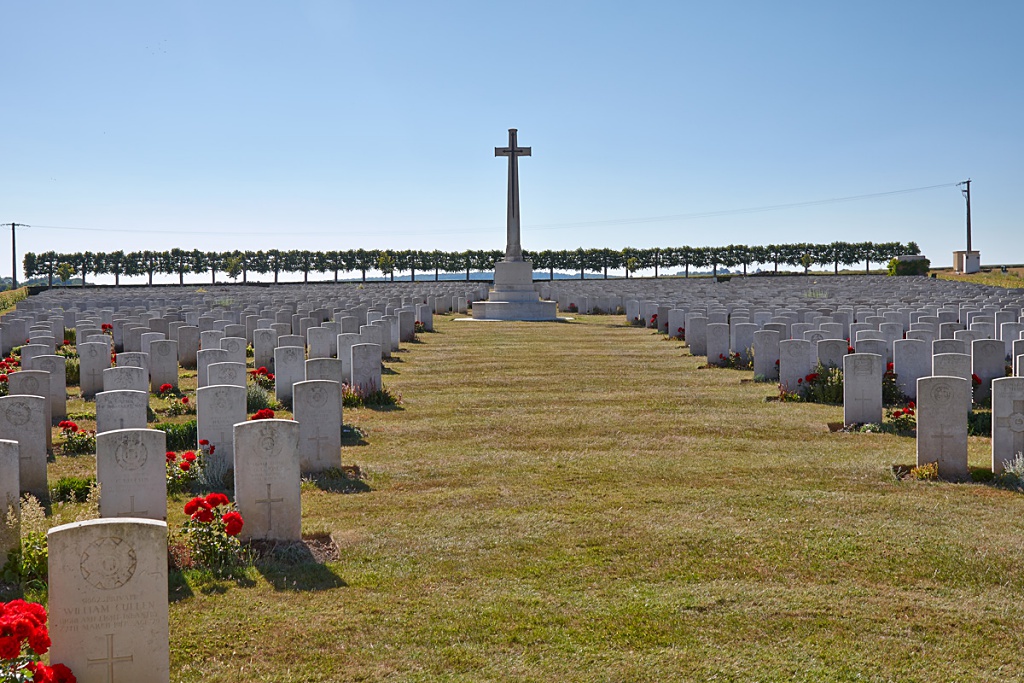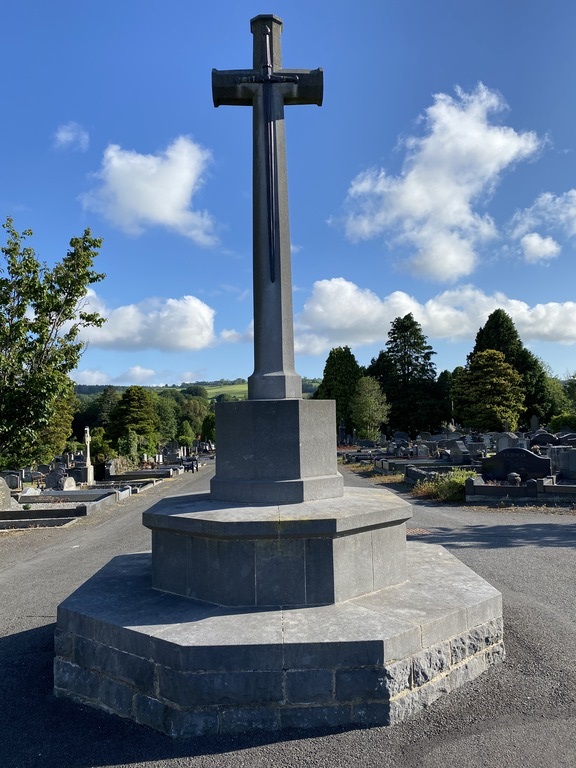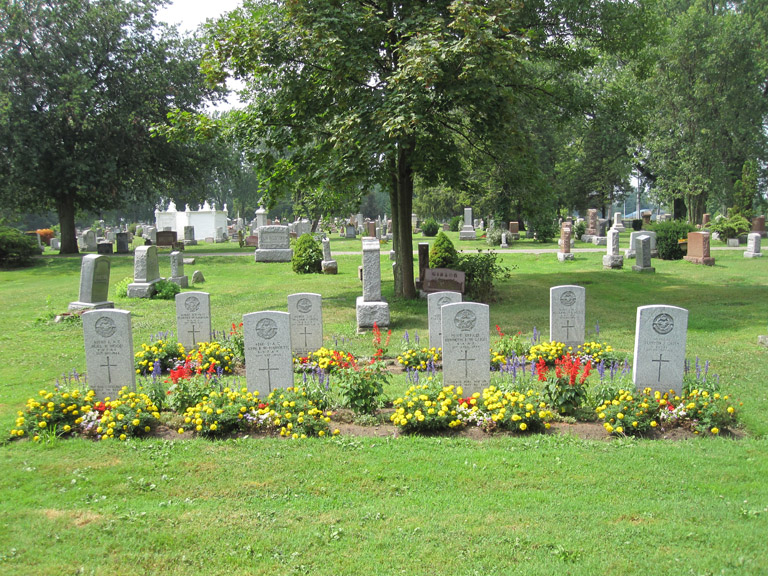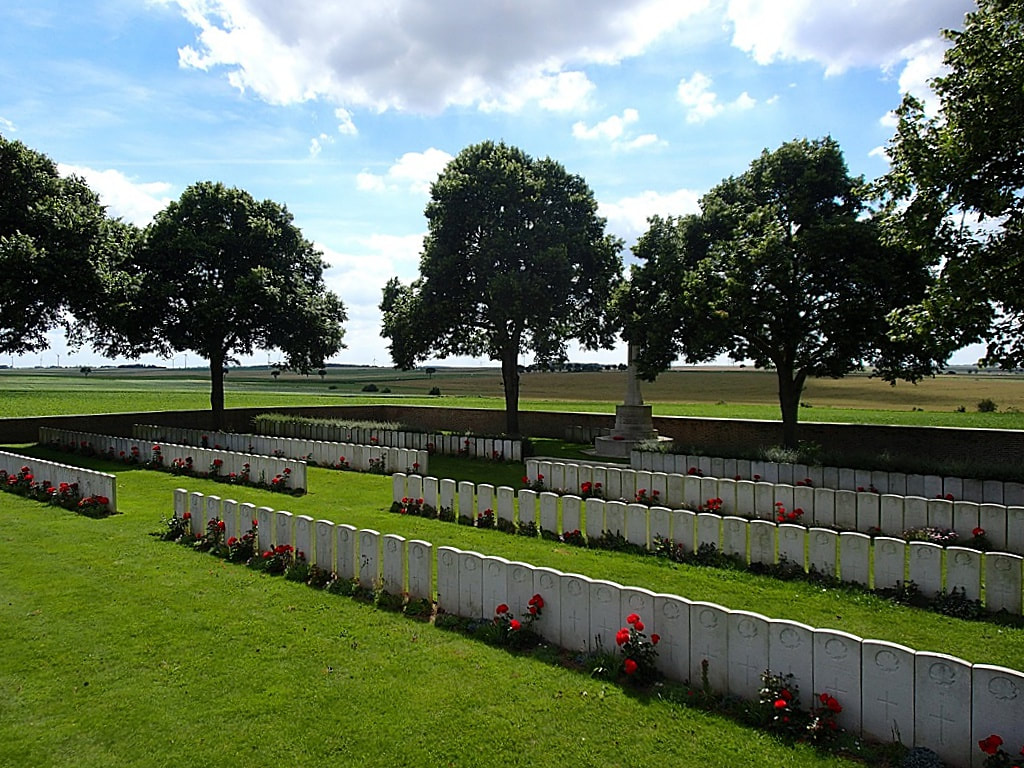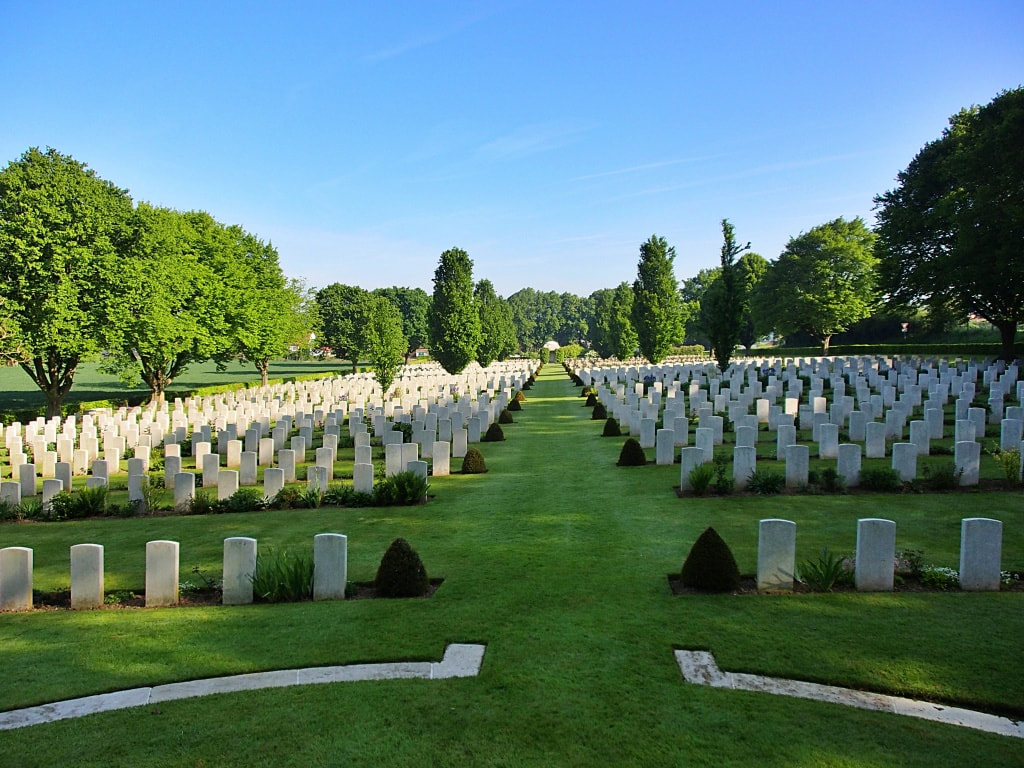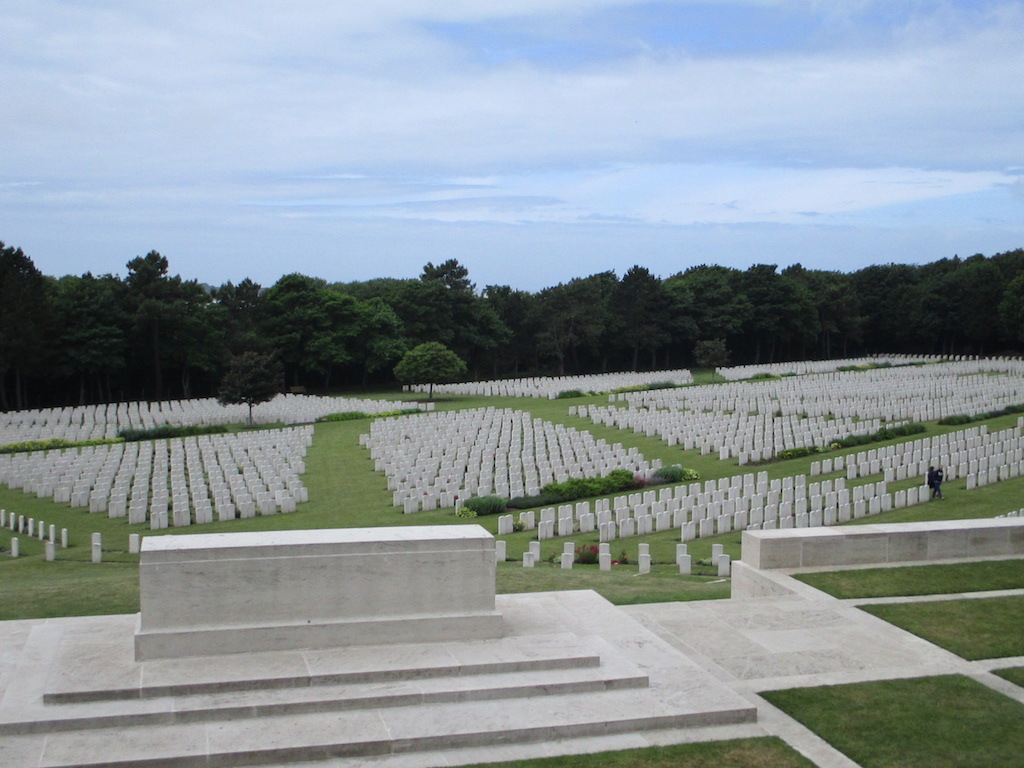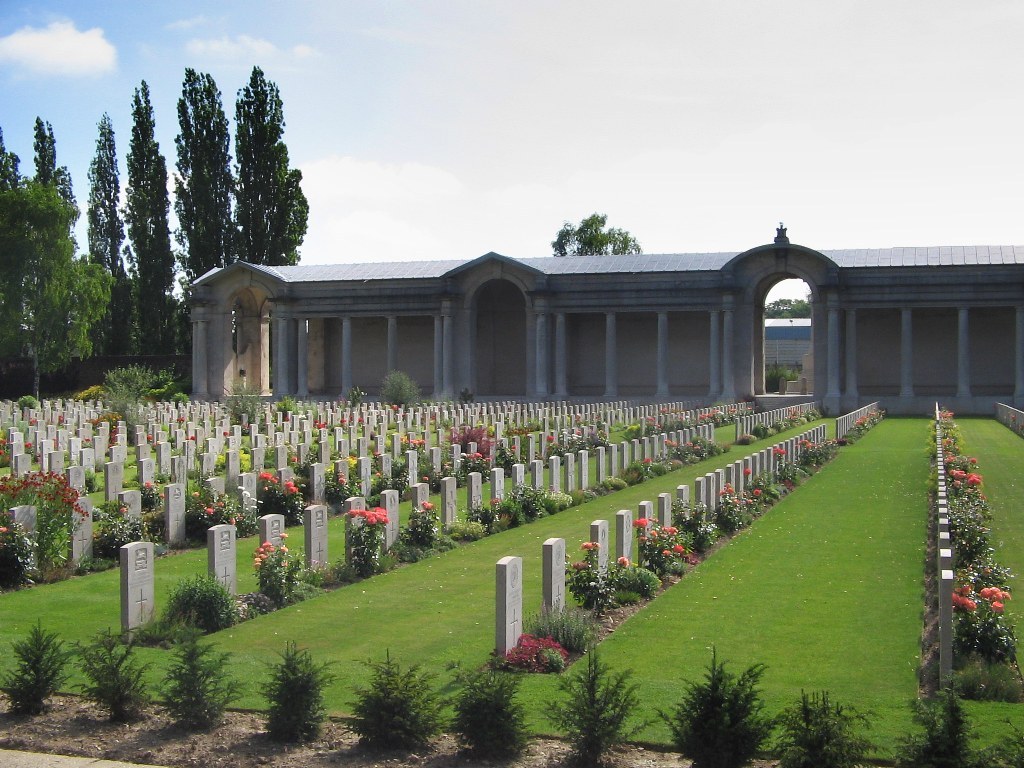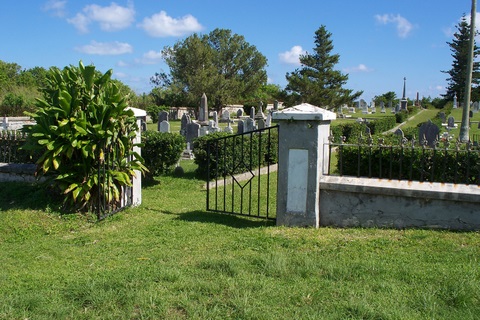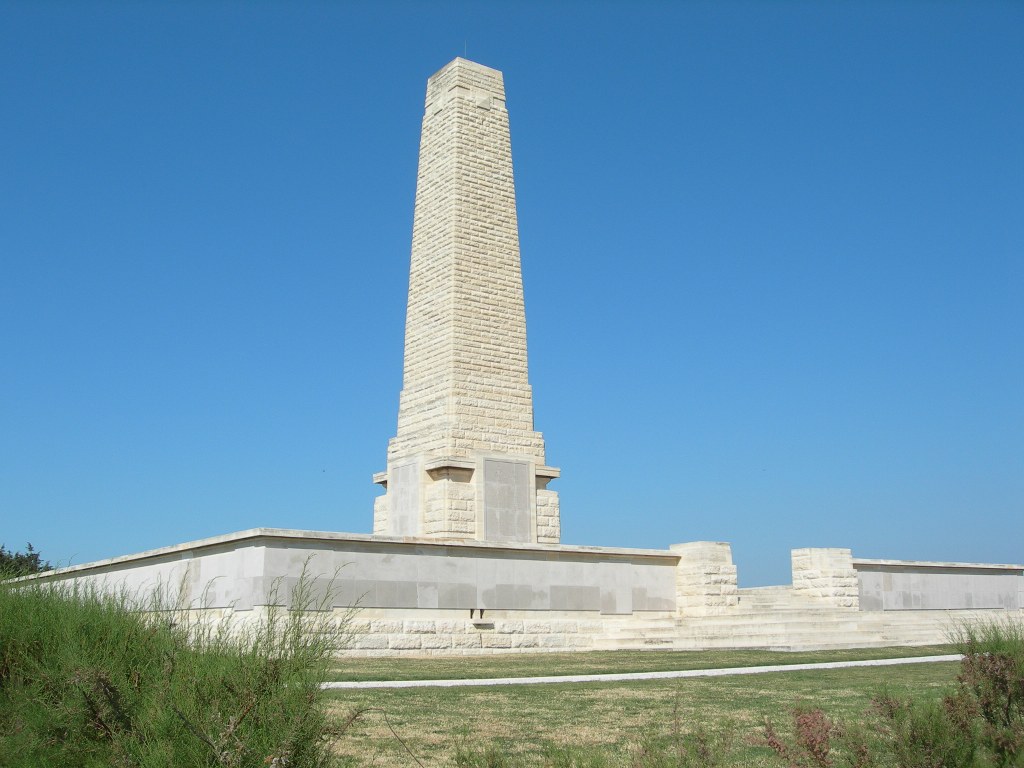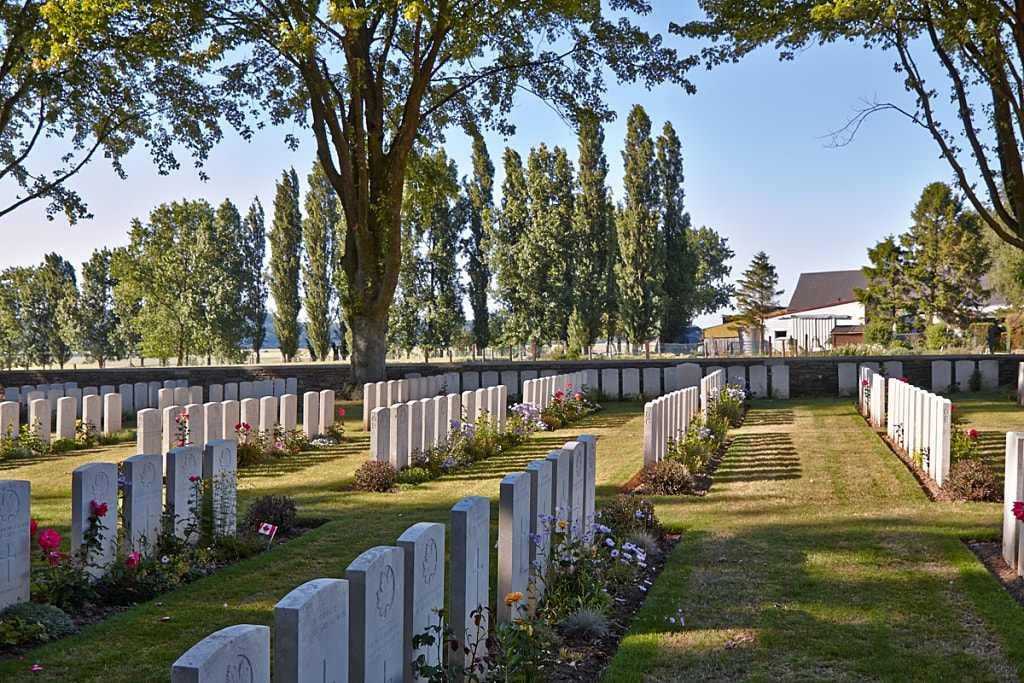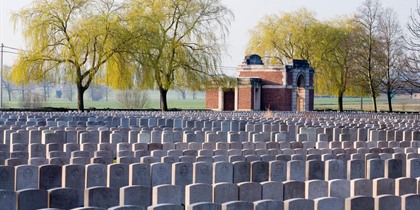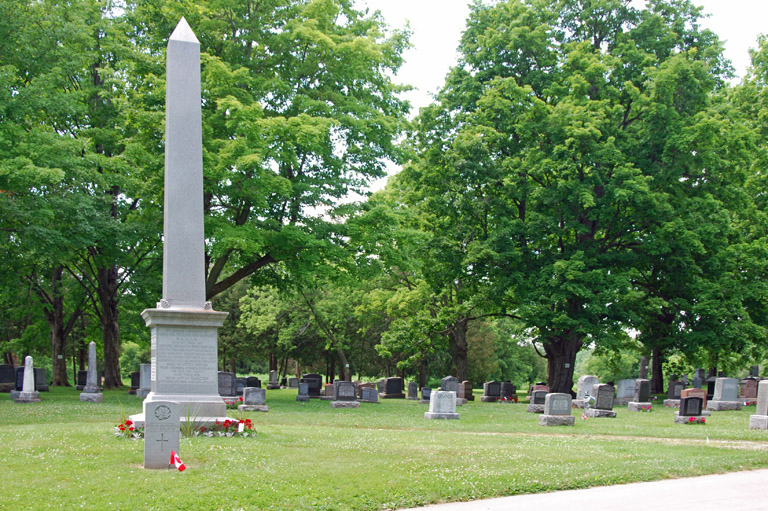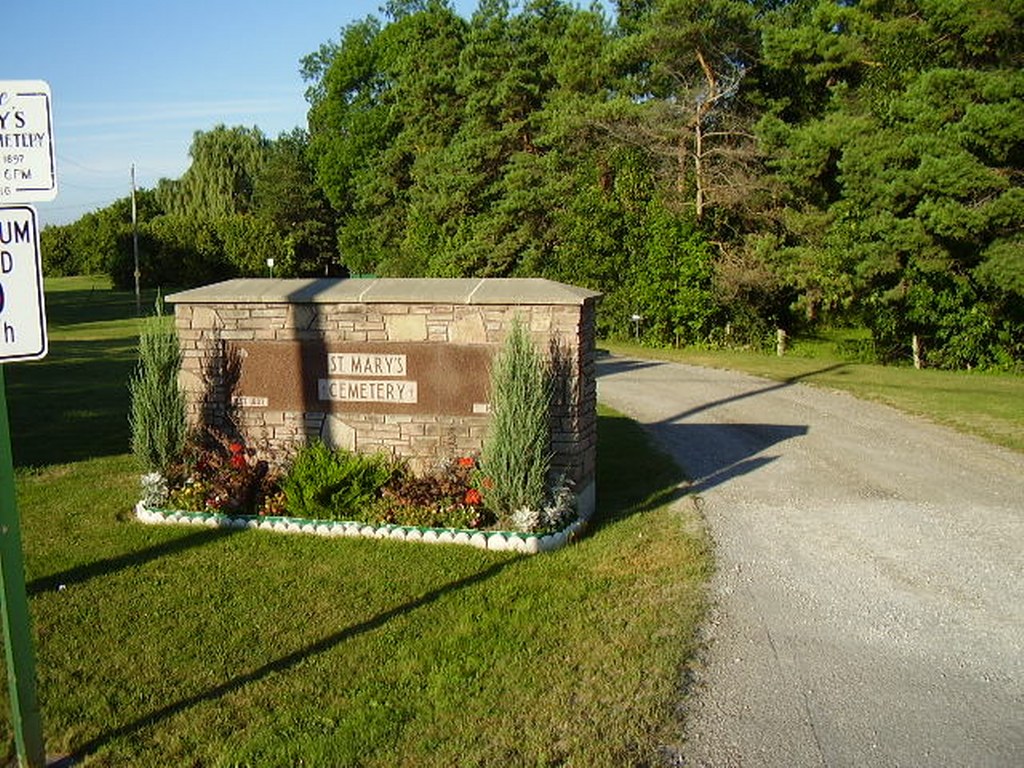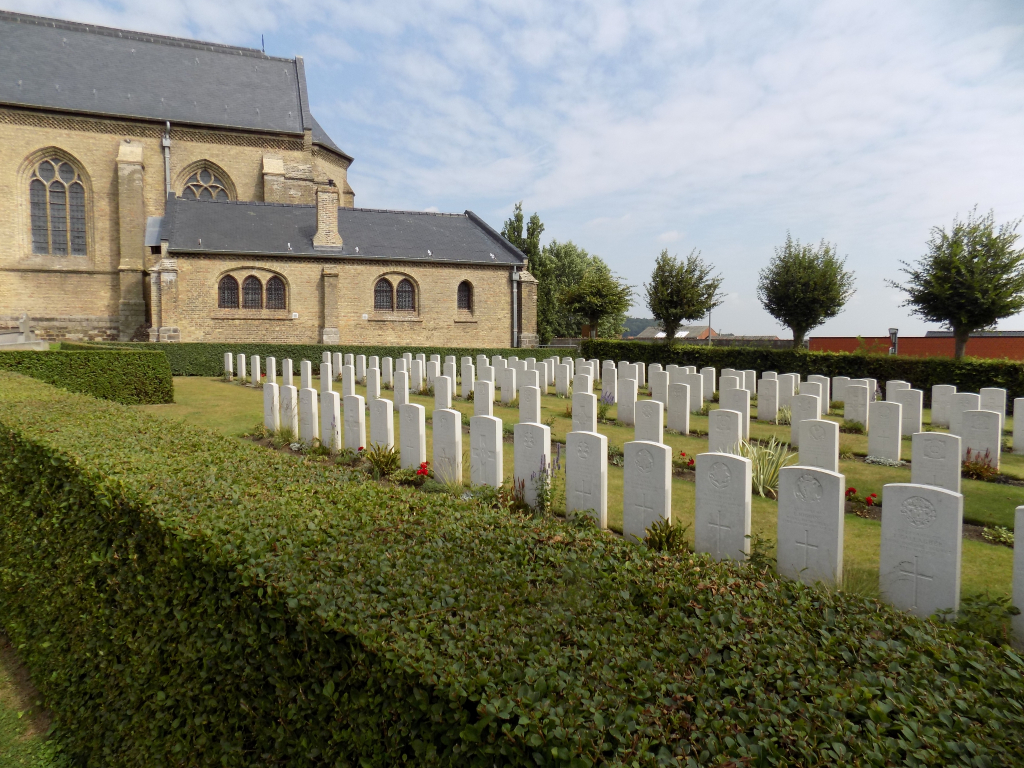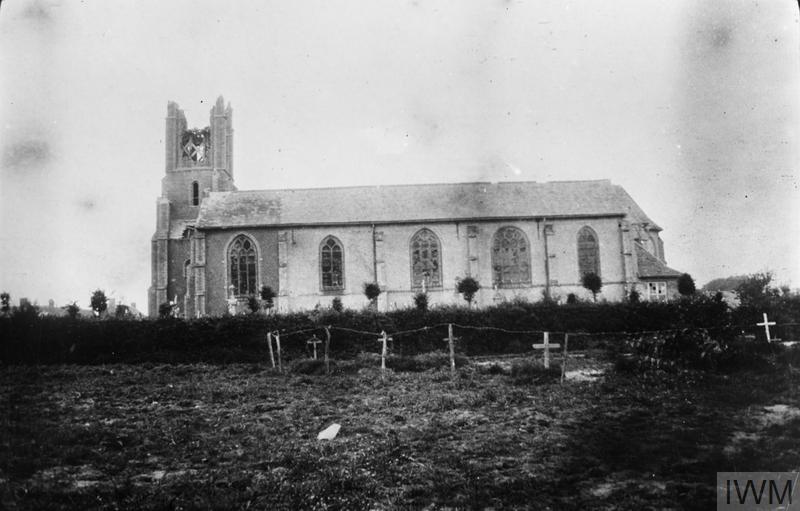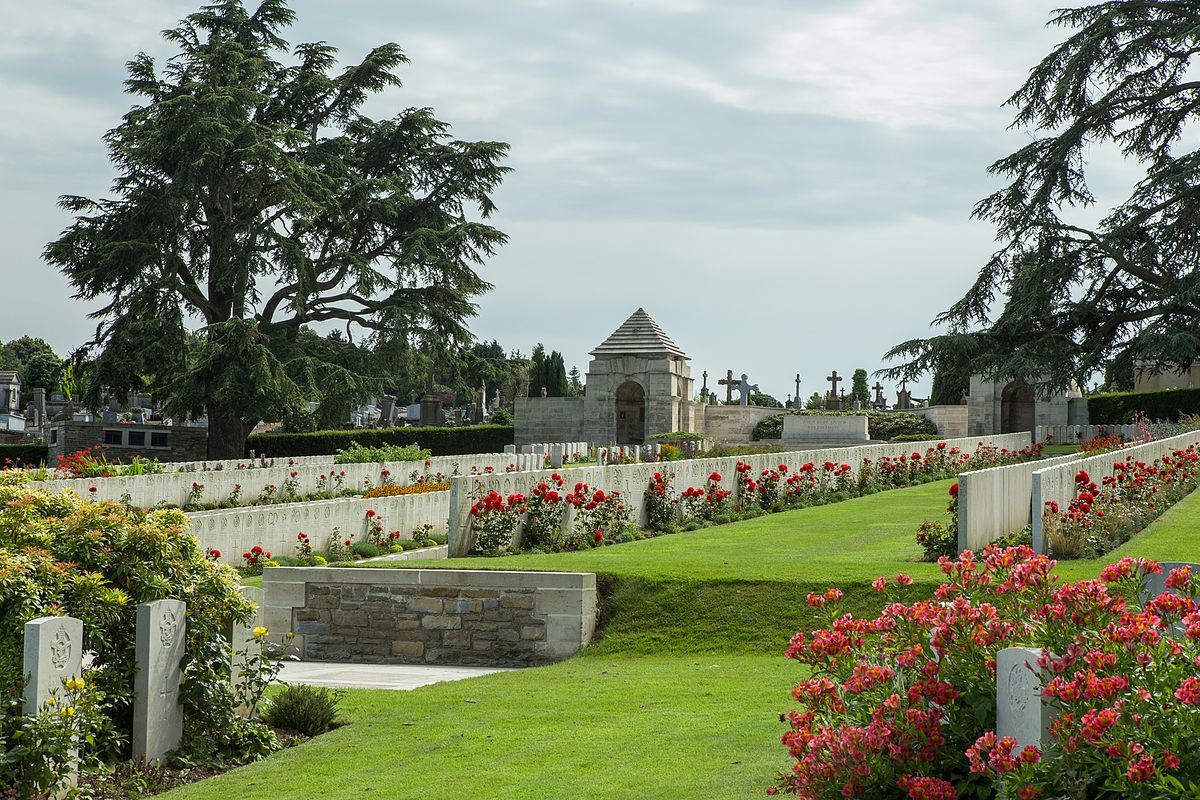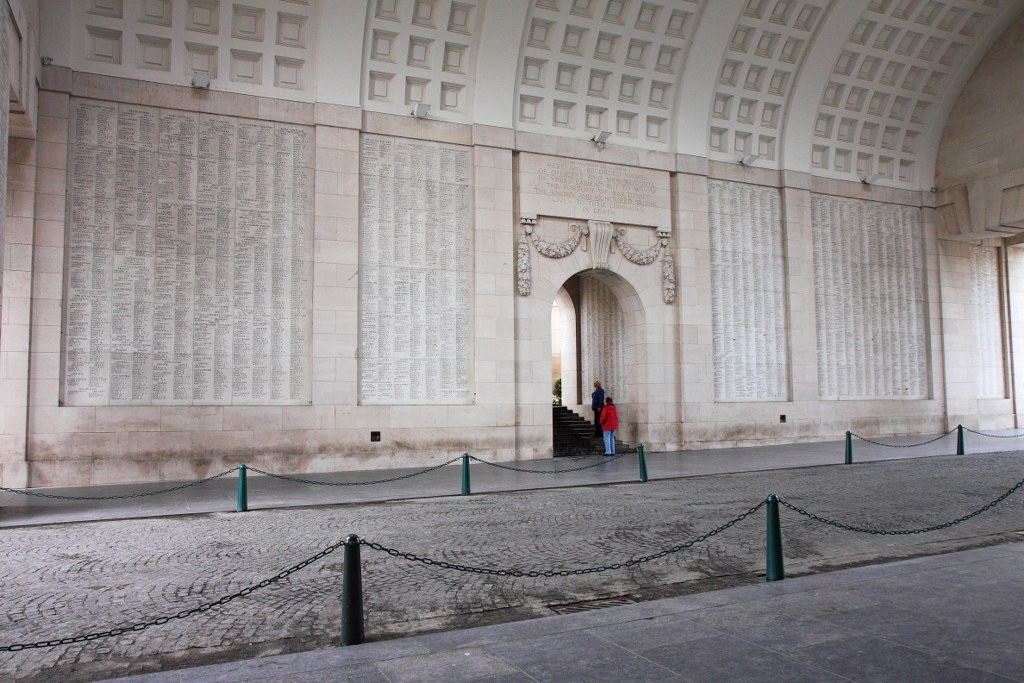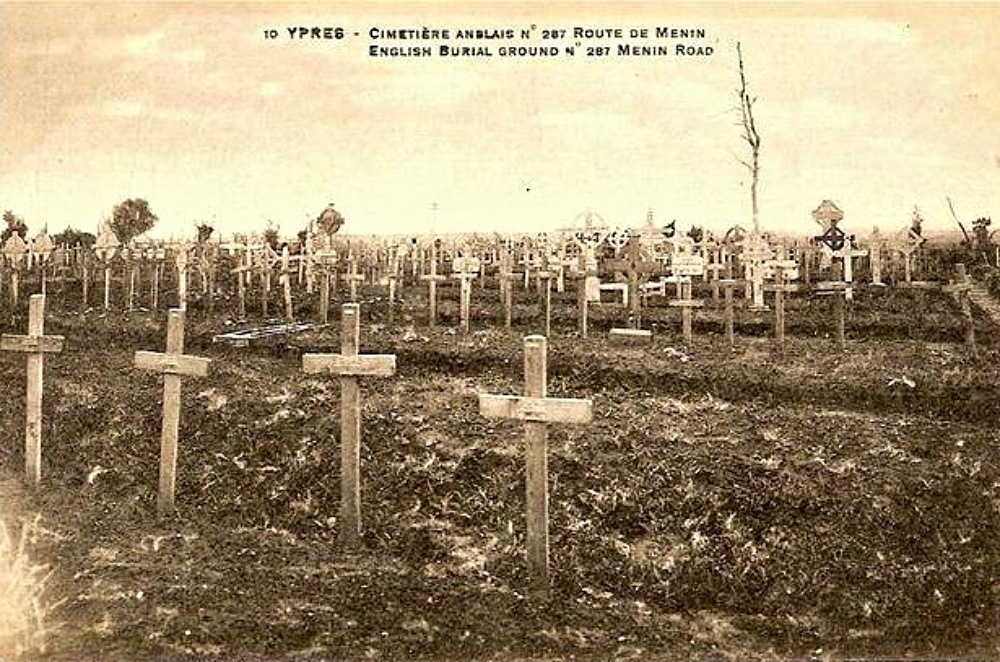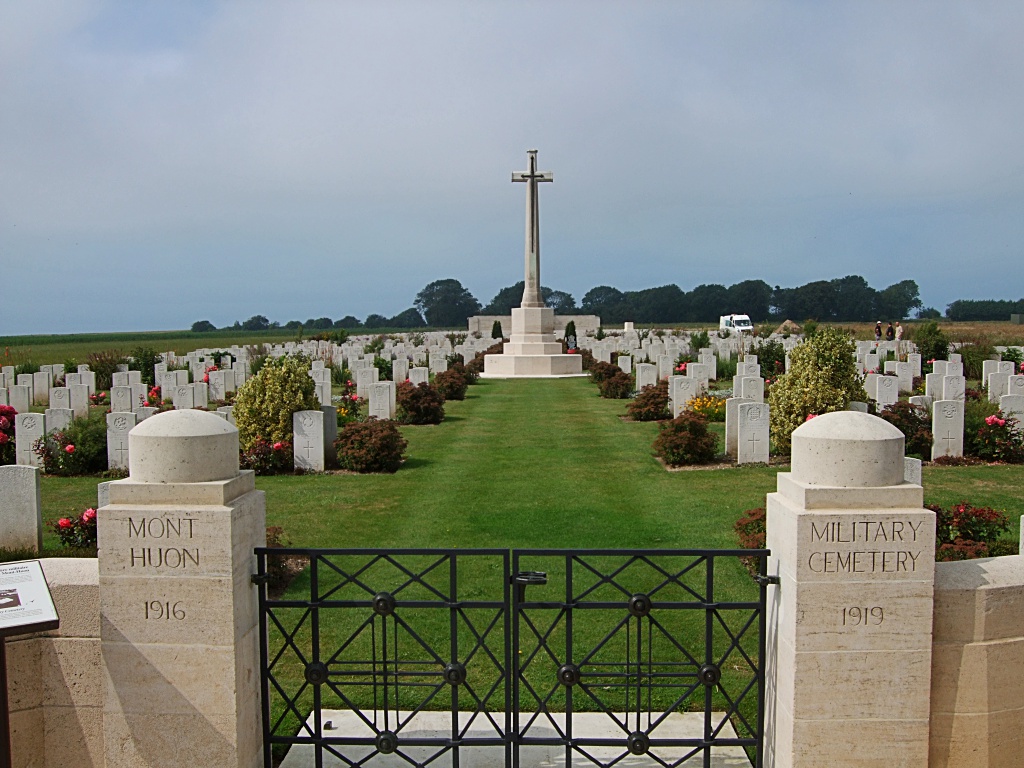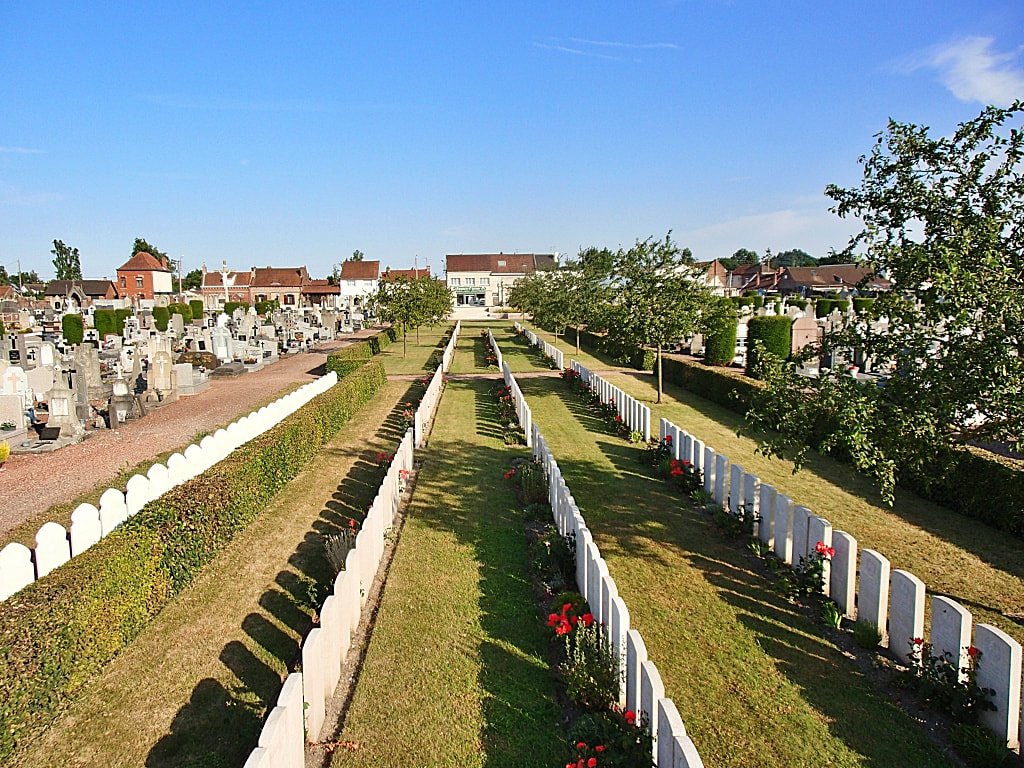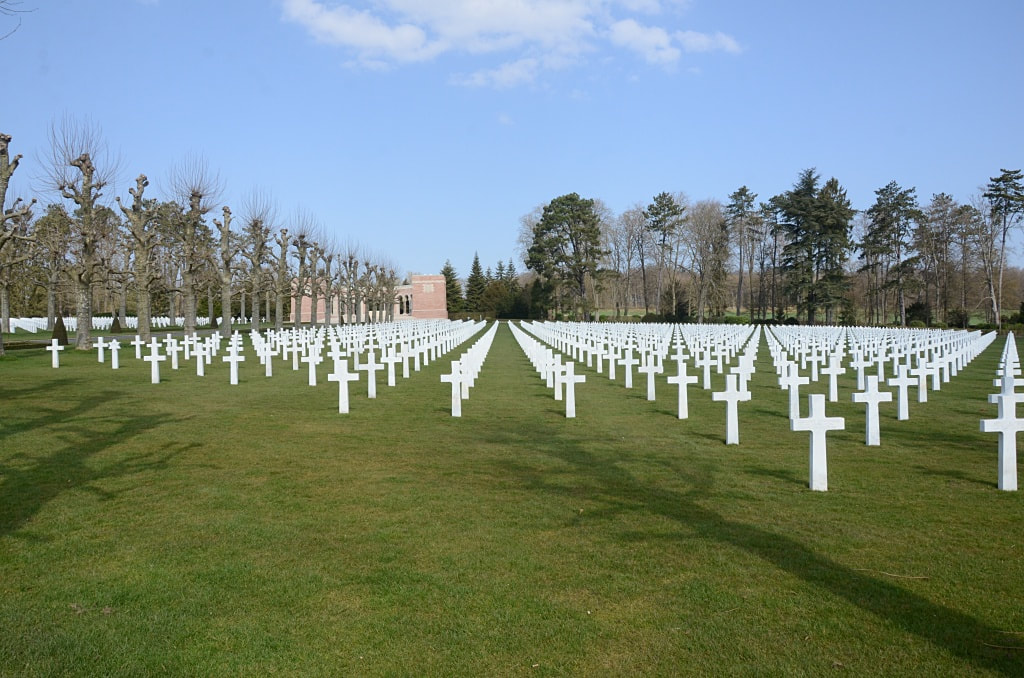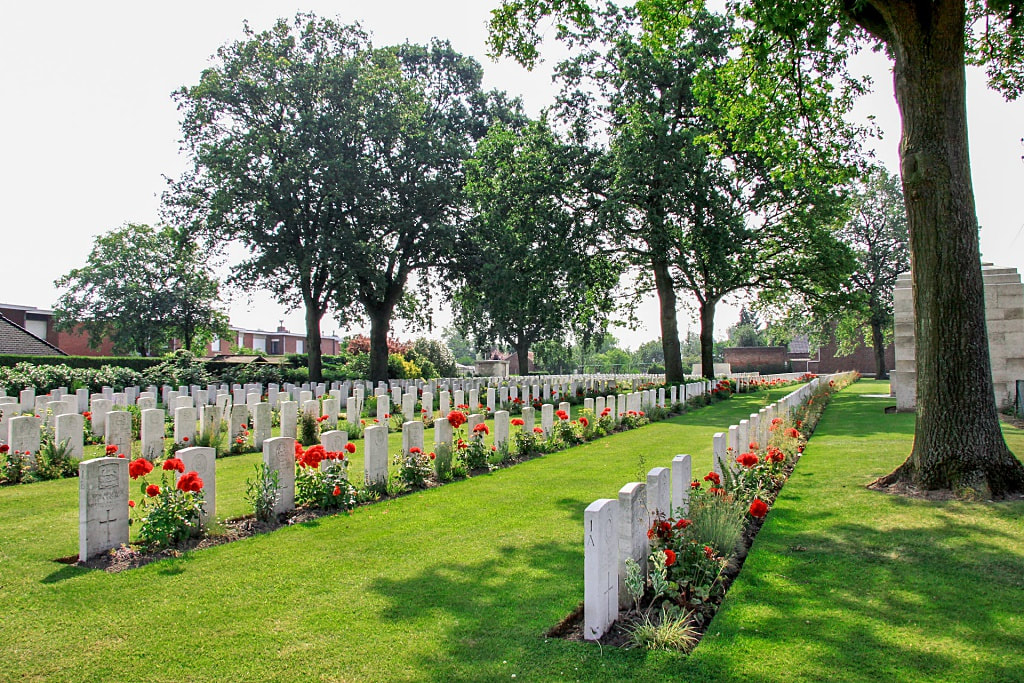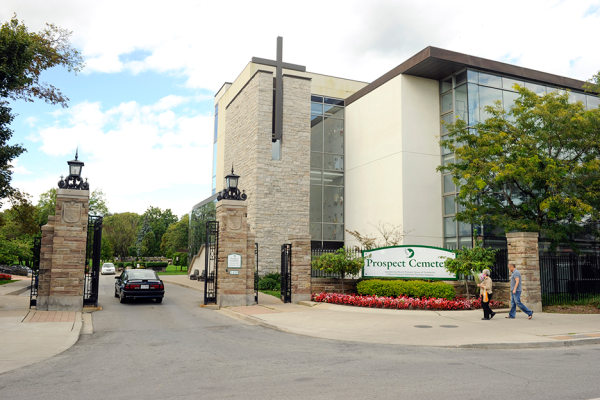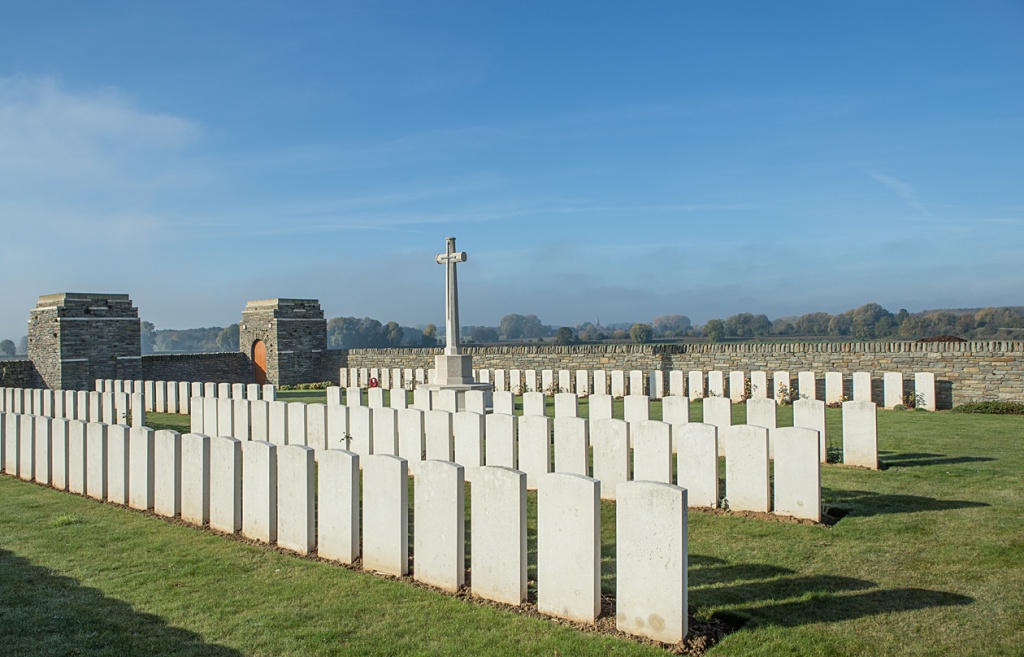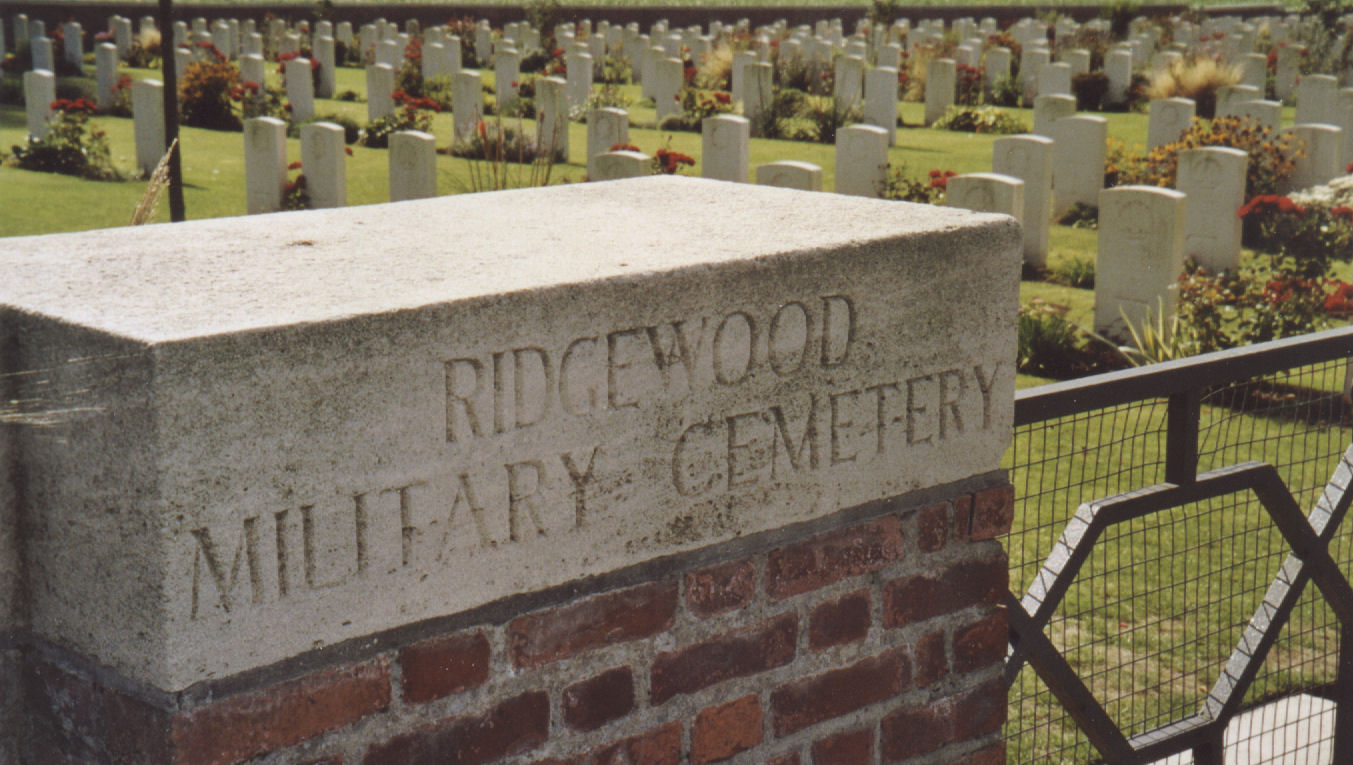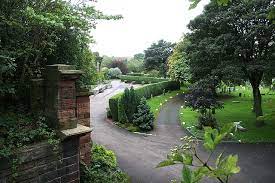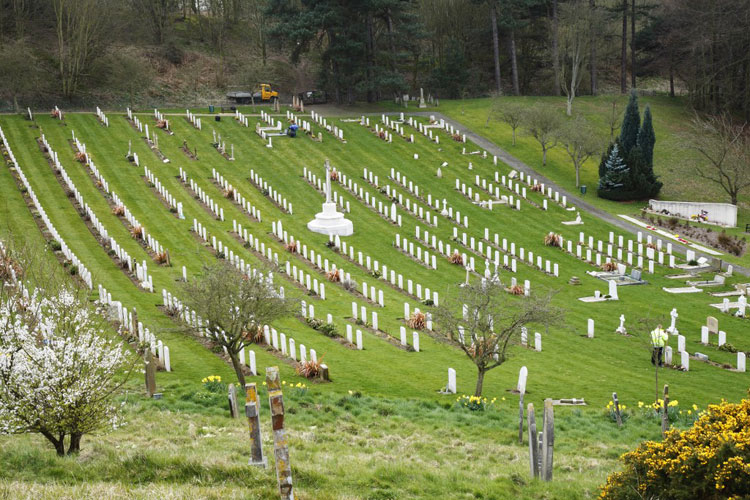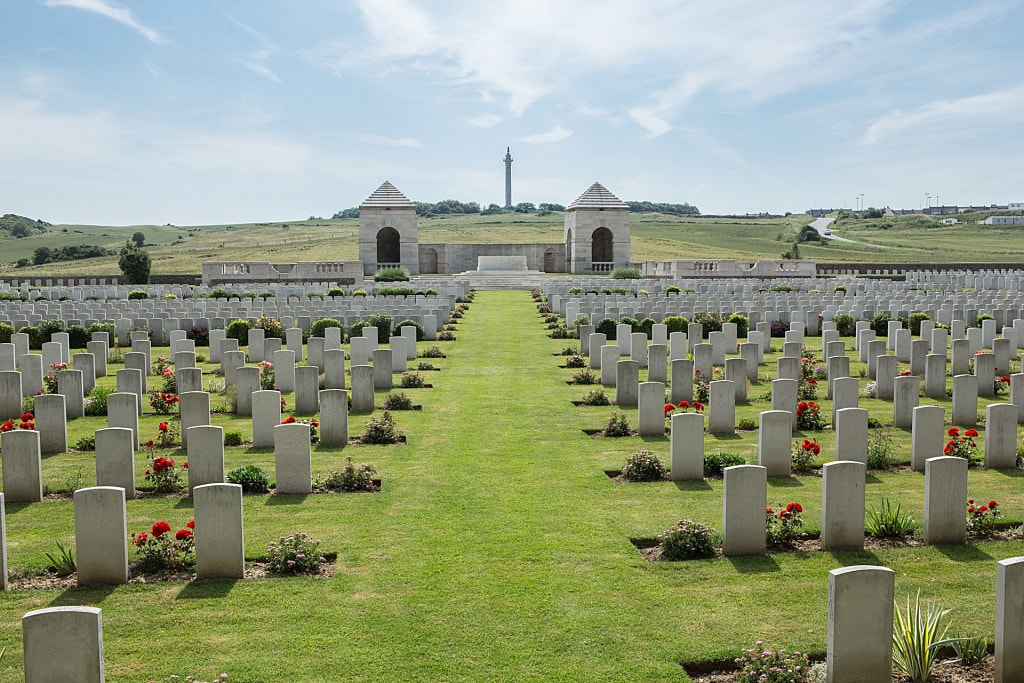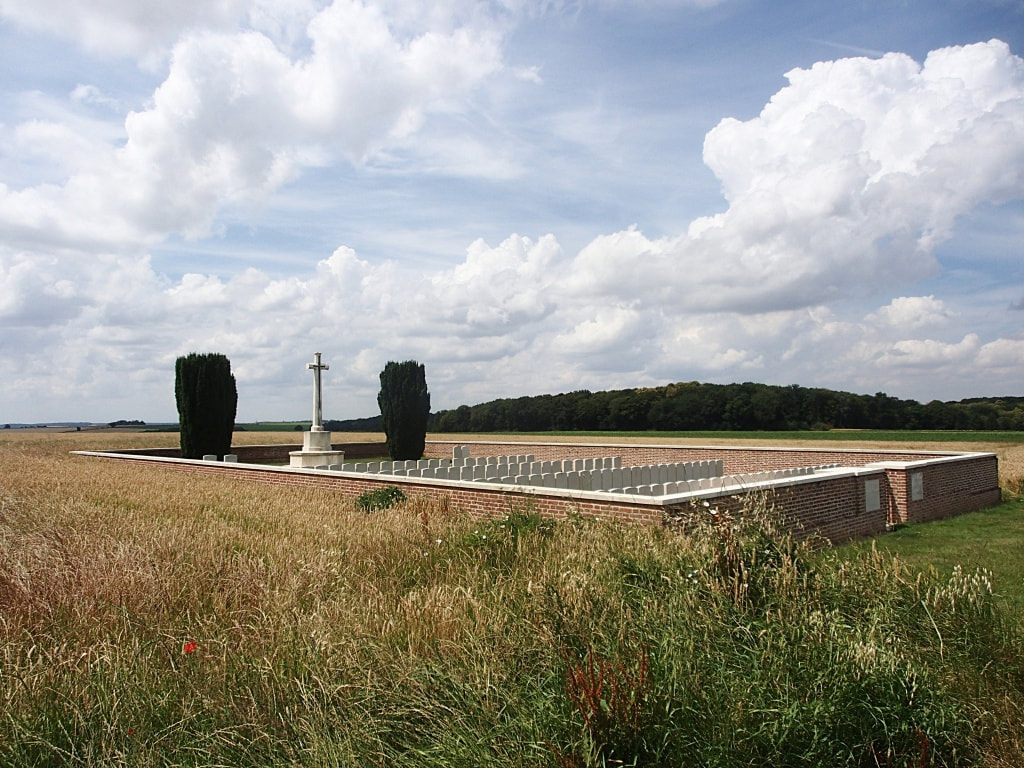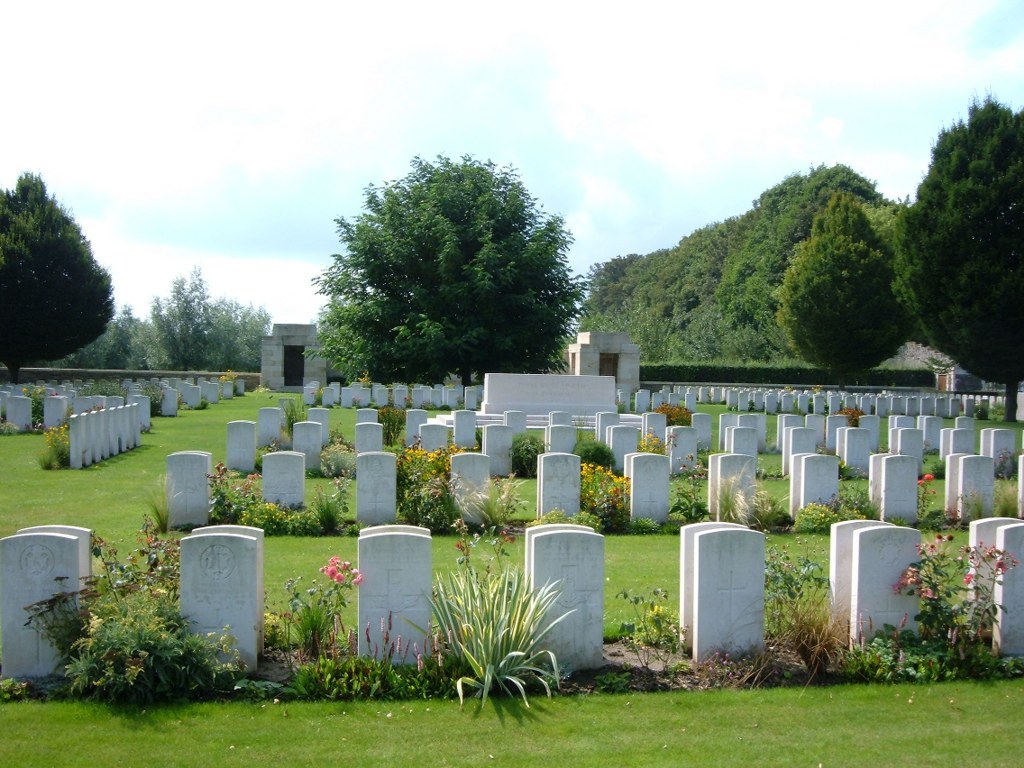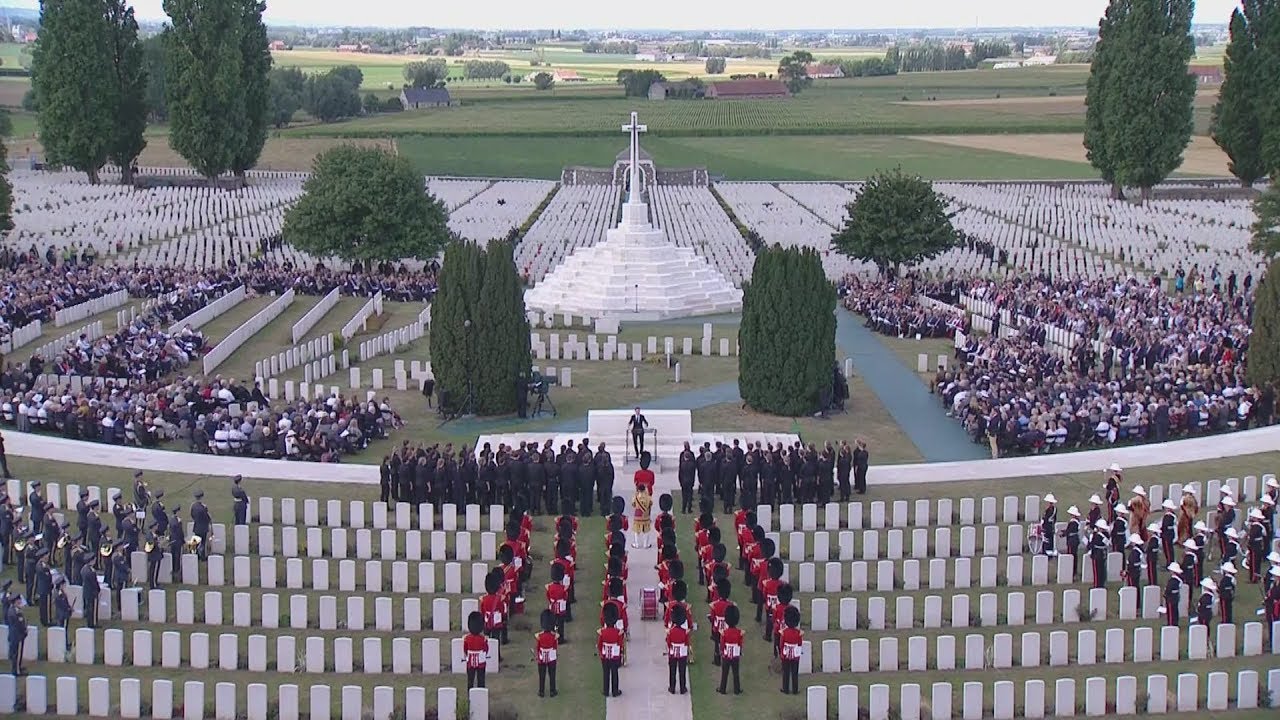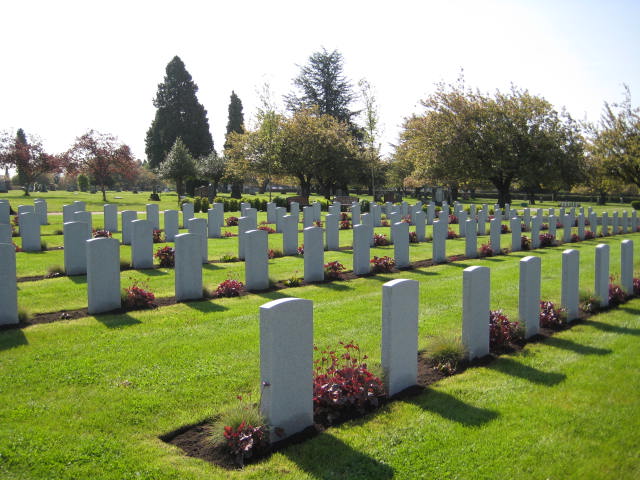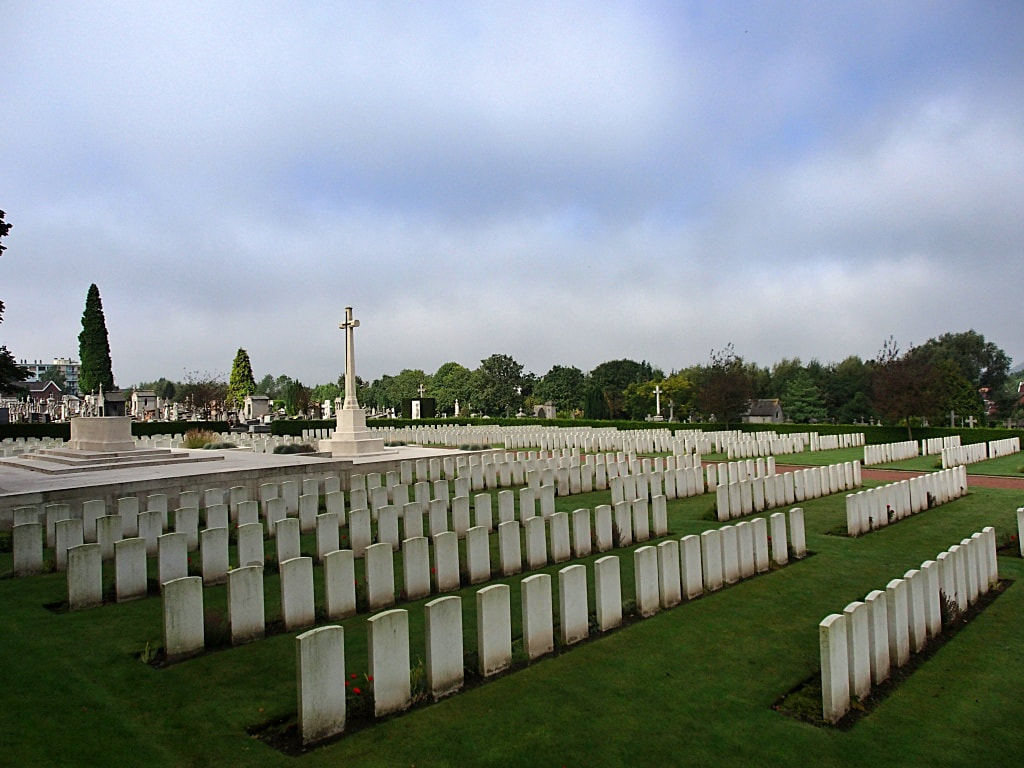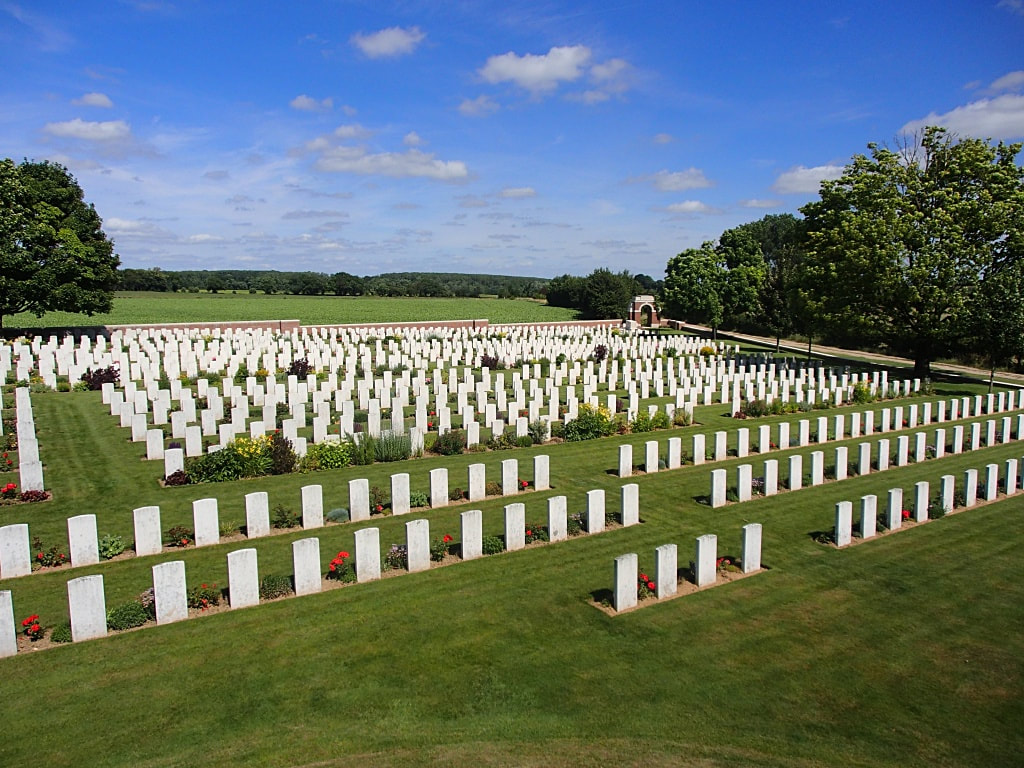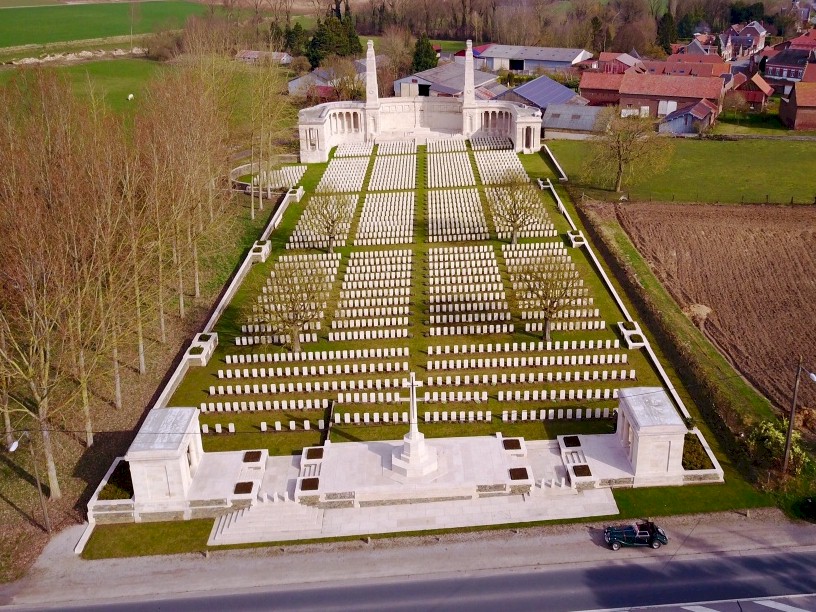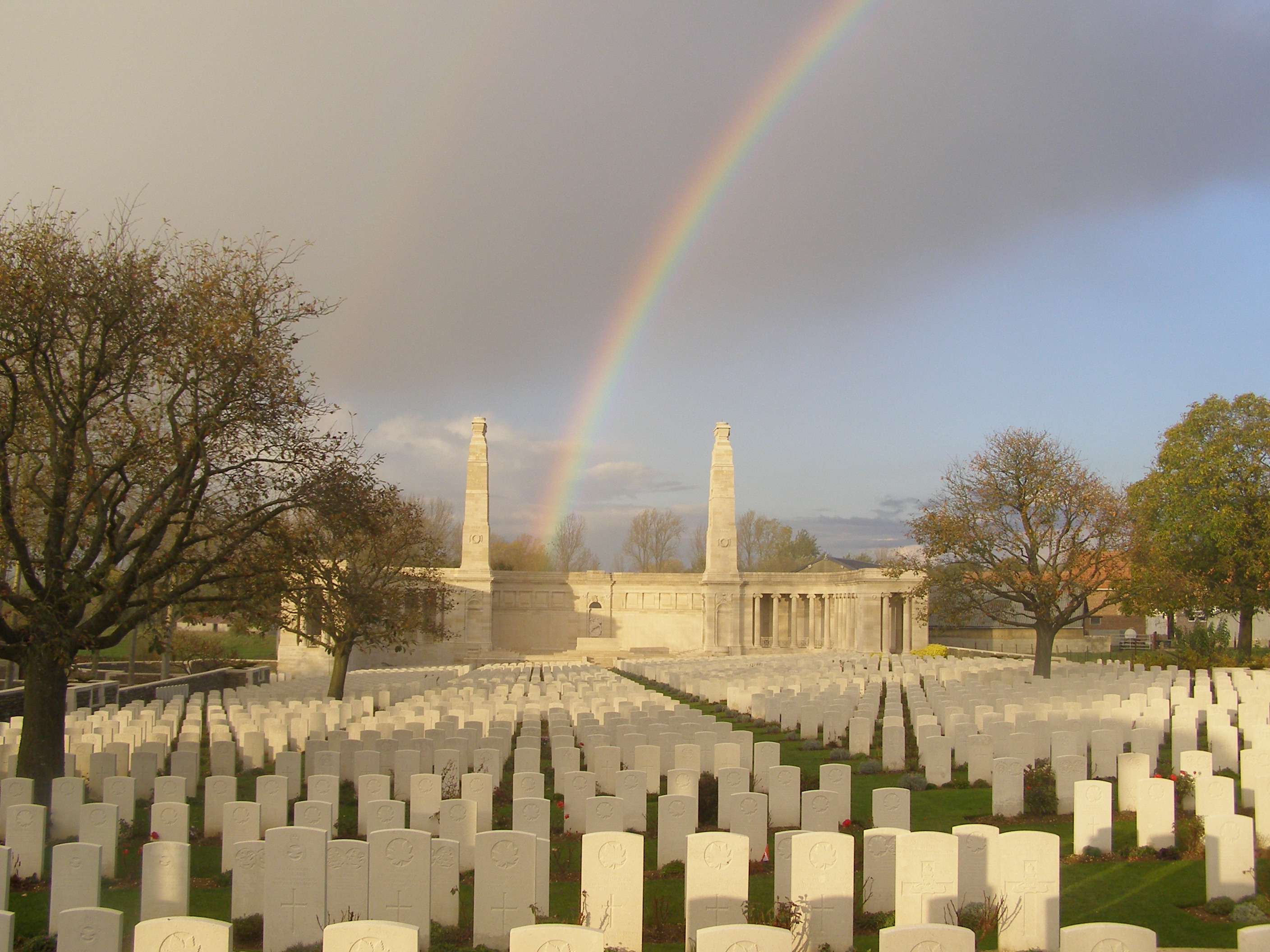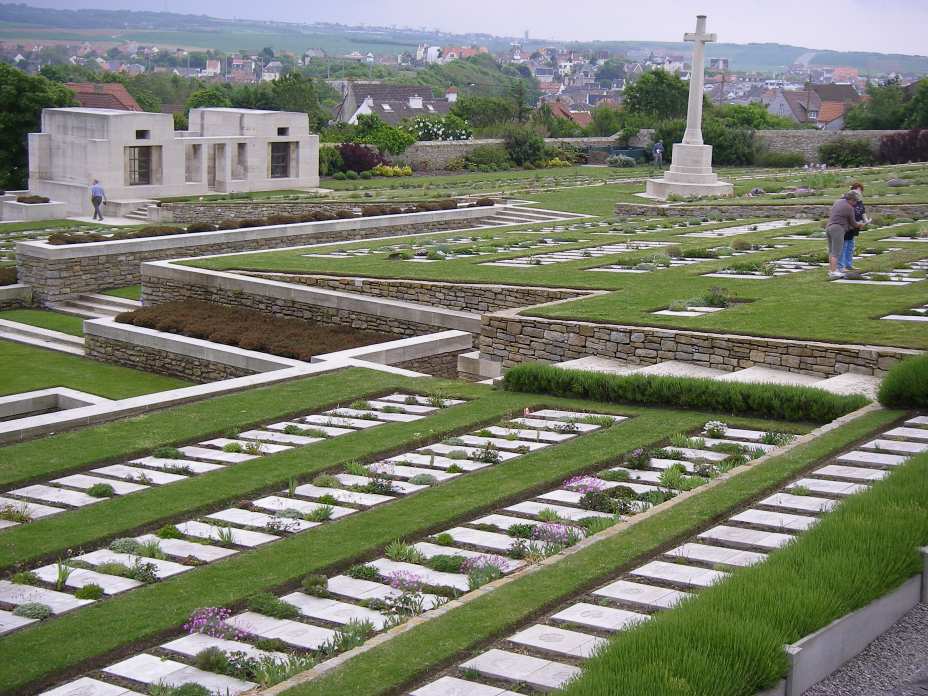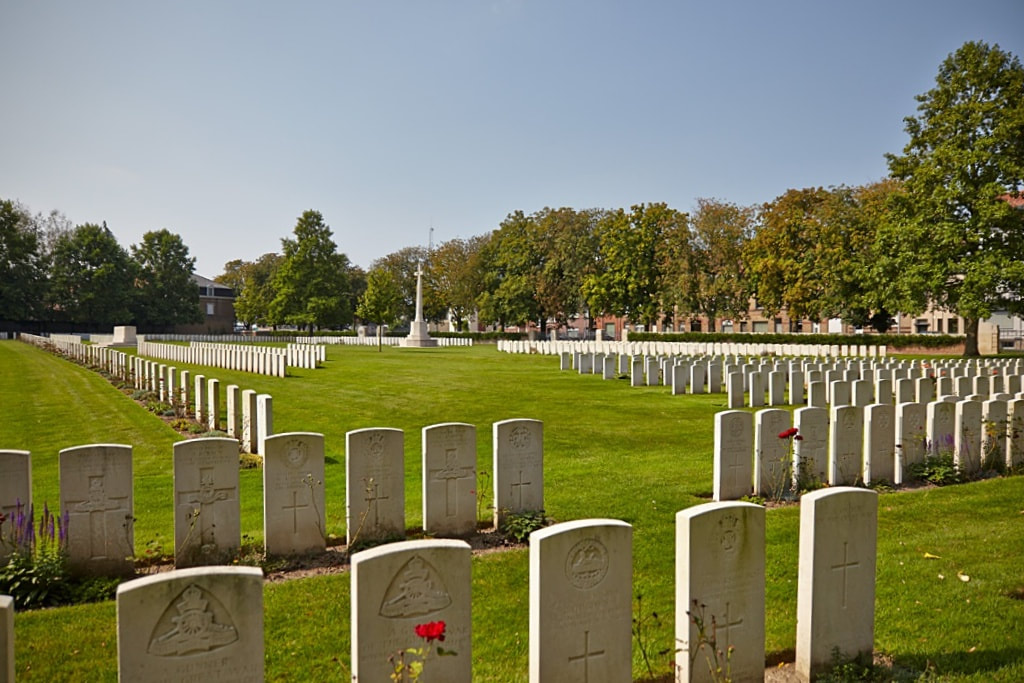Vimy Memorial
Canada's most impressive tribute overseas to those Canadians who fought and gave their lives in the First World War is the majestic and inspiring Vimy Memorial, which overlooks the Douai Plain from the highest point of Vimy Ridge, about eight kilometres northeast of Arras on the N17 towards Lens. The Memorial is signposted from this road to the left, just before you enter the village of Vimy from the south. The memorial itself is someway inside the memorial park, but again it is well signposted. At the base of the memorial, these words appear in French and in English: TO THE VALOUR OF THEIR COUNTRYMEN IN THE GREAT WAR AND IN MEMORY OF THEIR SIXTY THOUSAND DEAD THIS MONUMENT IS RAISED BY THE PEOPLE OF CANADA Inscribed on the ramparts of the Vimy Memorial are the names of over 11,000 Canadian soldiers who were posted as 'missing, presumed dead' in France. A plaque at the entrance to the memorial states that the land for the battlefield park, 91.18 hectares in extent, was 'the free gift in perpetuity of the French nation to the people of Canada'. Construction of the massive work began in 1925, and 11 years later, on July 26, 1936, the monument was unveiled by King Edward VIII. The park surrounding the Vimy Memorial was created by horticultural experts. Canadian trees and shrubs were planted in great masses to resemble the woods and forests of Canada. Wooded parklands surround the grassy slopes of the approaches around the Vimy Memorial. Trenches and tunnels have been restored and preserved and the visitor can picture the magnitude of the task that faced the Canadian Corps on that distant dawn when history was made. On April 3, 2003, the Government of Canada designated April 9th of each year as a national day of remembrance of the Battle of Vimy Ridge.Adanac Military Cemetery
Miraumont is a village about 14.5 Kms north-north-east of Albert and the Cemetery is some 3 Kms south of the village on the east side of the road to Courcelette (D107). The cemetery is signposted in the centre of Miraumont. The villages of Miraumont and Pys were occupied on 24-25 February 1917 following the German withdrawal to the Hindenburg Line. They were retaken by the Germans on 25 March 1918, but recovered the 42nd (East Lancashire) Division on the following 24 August. Adanac Military Cemetery (the name was formed by reversing the name "Canada") was made after the Armistice when graves were brought in from the Canadian battlefields around Courcelette and small cemeteries surrounding Miraumont, including:-- PYS BRITISH CEMETERY, about two thirds of the way from Pys to Courcelette. It contained the graves of 22 soldiers from Canada, two from the United Kingdom and five of unknown Units, and a memorial to 33 men of the Seaforth Highlanders of Canada.
- PYS NEW BRITISH CEMETERY, in the village, made by the 42nd Division in August and September, 1918, and containing the graves of 35 soldiers (and sailors and Marines) from the United Kingdom and one from New Zealand.
- AQUEDUCT ROAD CEMETERY, PYS, between Pys and Le Sars, made by the 6th and 99th Infantry Brigades in March, 1917, and containing the graves of eleven soldiers from the United Kingdom.
- NEW ZEALAND CEMETERY, GREVILLERS, close to Grevillers Churchyard, containing the graves of 19 New Zealand soldiers who fell in August-September, 1918.
- SHRINE CEMETERY, GREVILLERS, about 500 metres from Grevillers on the road to Irles, containing the graves of thirteen soldiers from New Zealand and two from the United Kingdom who fell at the end of August, 1918.
- One grave (Plot IV, Row B, Grave 30) was left in its original position.
There are now 3,187 Commonwealth burials and commemorations of the First World War in this cemetery. 1,709 of the burials are unidentified but special memorials commemorate 13 casualties known or believed to be buried among them.
Aix-Noulette Communal Cemetery
The cemetery covers an area of 5,198 square metres and is enclosed by a red brick wall on three sides, and on the South by the wall of the Communal Cemetery. The Cemetery Extension was begun by French troops early in 1915, and the two French plots are next to the Communal Cemetery. It was taken over by the 1st and 2nd Divisions in February, 1916, and used by fighting units and Field Ambulances until October, 1918. It was increased after the Armistice by the concentration of graves from the battlefields to the East. There are now 749 Commonwealth burials of the 1914-1918 war commemorated here, 61 are unidentified. There are also 502 French burials here.Commonwealth Identified Casualties: Canada 482, United Kingdom 206. Total 688.
UnIdentified Casualties: Canada 10., United Kingdom 51. Total 61.
Other Nationalities: France 502.
Anzin-St.Aubin British Cemetery
The cemetery was begun by the 51st (Highland) Division early in April 1917, and carried on by artillery units and field ambulances until October 1917. It was then used by the 30th and 57th Casualty Clearing Stations. The 51st Division came back to it in April 1918 and it was closed the following September. The graves of three Indian cavalrymen were brought to it from ANZIN-ST. AUBIN FRENCH MILITARY CEMETERY, which was West of the village, in 1922. The cemetery contains 358 First World War burials, 145 of which belonged, or were attached, to Artillery units. There are also four Second World War burials, all dating from the British Expeditionary Force's period in France during the early months of the war before the German invasion.Total Burials: 362.
World War One Identified Casualties: United KIngdom 290, Canada 63, India 4. Total 357
World War Two Identified Casualties: United Kingdom 4
Arras Flying Services Memorial
The Arras Flying Services Memorial is in the Faubourg-d'Amiens Cemetery, which is in the Boulevard du General de Gaulle in the western part of the town of Arras, near the Citadel, approximately 2 kilometres due west of the railway station.Ashford Cemetery
The cemetery opened in 1859. It is open to visitors every day, including Christmas and Boxing Day, from 7:30am to sunset. It contains 45 identified military graves, from both world wars.Barlin Communal Cemetery Extension
Barlin is a village about 11 km south-west of Bethune on the D188, between the Bethune-Arras and Bethune-St. Pol roads, about 6.5 Kms south-east of Bruay. The Communal Cemetery and Extension lie to the north of the village on the D171 road to Houchin. The extension was begun by French troops in October 1914 and when they moved south in March 1916 to be replaced by Commonwealth forces, it was used for burials by the 6th Casualty Clearing Station. In November 1917, Barlin began to be shelled and the hospital was moved back to Ruitz, but the extension was used again in March and April 1918 during the German advance on this front.The Extension contains 1094 Commonwealth burials of the First World War and a number of French and German war graves. Some French civilians killed in a colliery accident in 1917 are also buried in the extension.
Bedford House Cemetery
Zillebeke village and most of the commune were in the hands of Commonwealth forces for the greater part of the First World War, but the number of cemeteries in the neighbourhood bears witness to the fierce fighting in the vicinity from 1914 to 1918. Bedford House, sometimes known as Woodcote House, were the names given by the Army to the Chateau Rosendal, a country house in a small wooded park with moats. Although it never fell into German hands, the house and the trees were gradually destroyed by shell fire. It was used by field ambulances and as the headquarters of brigades and other fighting units, and charcoal pits were dug there from October 1917. In time, the property became largely covered by small cemeteries; five enclosures existed at the date of the Armistice, but the graves from No.1 were then removed to White House Cemetery, St. Jean, and those from No.5 to Aeroplane Cemetery, Ypres. ENCLOSURE No.2 was begun in December 1915, and used until October 1918. After the Armistice, 437 graves were added, all but four of which came from the Ecole de Bienfaisance and Asylum British Cemeteries, both at Ypres. ENCLOSURE No.3, the smallest, was used from February 1915 to December 1916; the burials made in August-October 1915 were largely carried out by the 17th Division. ENCLOSURE No.4, the largest, was used from June 1916 to February 1918, largely by the 47th (London) Division, and after the Armistice it was enlarged when 3,324 graves were brought in from other burial grounds and from the battlefields of the Ypres Salient. Almost two-thirds of the graves are unidentified. ENCLOSURE No.6 was made in the 1930s from the graves that were continuing to be found on the battlefield of the Ypres Salient. This enclosure also contains Second World War burials, all of them soldiers of the British Expeditionary Force, who died in the defence of the Ypres-Comines canal and railway at the end of May 1940. The canal lies on high ground on the west side of the cemetery. In all, 5,139 Commonwealth servicemen of the First World War are buried or commemorated in the enclosures of Bedford House Cemetery. 3,012 of the burials are unidentified but special memorials commemorate a number of casualties known or believed to be buried among them. Other special memorials name casualties buried in other cemeteries whose graves could not be found on concentration. Second World War burials number 69 (3 of which are unidentified). There are 2 Germans buried here.World War One Identified Casualties: United Kingdom 1,760, Canada 218, Australia 122, New Zealand 17, India 8, South Africa 3, Germany 1. Total 2,129.
World War One UnIdentified Casualties: 3,012.
Bellacourt Military Cemetery
Bellacourt is a village in the commune of Riviere, in the Department of the Pas-de-Calais, 10 kilometres south-west of Arras. The cemetery was begun by French troops in October 1914, and carried on by the 46th (North Midland), 55th (West Lancashire), 58th (London), 49th (West Riding) and other Divisions, and later by the Canadian Corps, from February 1916, to September 1918; and the French plot was increased in 1923 by concentrations from other cemeteries. The 16 American graves of July and August, 1918 (all but one of which belonged to the 320th Regiment) have been removed to another place of burial. There are 434 Commonwealth burials of the 1914-18 war commemorated in this site, 1 being unidentified. There are French burials here and 1 unknown German burial. The Cemetery covers an area of 3,582 square metres and is enclosed by a rubble wall.Total Burials: 549.
Identified Casualties: United Kingdom 260, Canada 173. Total 433.
Boulogne Eastern Cemetery
Boulogne, was one of the three base ports most extensively used by the Commonwealth armies on the Western Front throughout the First World War. It was closed and cleared on the 27 August 1914 when the Allies were forced to fall back ahead of the German advance, but was opened again in October and from that month to the end of the war, Boulogne and Wimereux formed one of the chief hospital areas. Until June 1918, the dead from the hospitals at Boulogne itself were buried in the Cimetiere de L'Est, one of the town cemeteries, the Commonwealth graves forming a long, narrow strip along the right hand edge of the cemetery. In the spring of 1918, it was found that space was running short in the Eastern Cemetery in spite of repeated extensions to the south, and the site of the new cemetery at Terlincthun was chosen. During the Second World War, hospitals were again posted to Boulogne for a short time in May 1940. The town was taken by the Germans at the end of that month and remained in their hands until recaptured by the Canadians on 22 September 1944. Boulogne Eastern Cemetery contains 5,583 Commonwealth burials of the First World War and 224 from the Second World War.Identified World War One Burials: United Kingdom 4,740, Canada 442, Australia 307, New Zealand 74, South Africa 15, India 5. Total 5,583.
Identified World War Two Burials: United Kingdom 164, Canada, 17, Poland 11, Australia 3. Total 195.
Boves West Communal Cemetery Extension
Boves is a village about 8 kilometres south-east of Amiens. Boves has two communal cemeteries, on either side of the river. The 49th Casualty Clearing Station was at Boves from 23 April to the end of August 1918 and the 1st Canadian and 4th Canadian during August 1918. The burials in the two communal cemeteries and the extension to the West cemetery are mainly those of soldiers who died in the three hospitals.Boves East Communal Cemetery contains 15 Commonwealth burials of the First World War.
Boves West Communal Cemetery contains 51 Commonwealth burials of the First World War and 12 French graves.
Brandhoek Military Cemetery
During the First World War, Brandhoek was within the area comparatively safe from shell fire which extended beyond Vlamertinghe Church. Field ambulances were posted there continuously and the Military Cemetery was opened early in May 1915 in a field adjoining the dressing station. It closed in July 1917 when the New Military Cemetery was opened nearby, to be followed by the New Military Cemetery No 3 in August 1917. Brandhoek Military Cemetery now contains 669 First World War burials.Brookwood Military Cemetery
In 1917, an area of land in Brookwood Cemetery (originally The London Necropolis) was set aside for the burial of men and women of the forces of the Commonwealth and Americans, who had died, many of battle wounds, in the London district. This site was further extended to accommodate the Commonwealth casualties of the Second World War, and American, Belgian, Czech, Dutch, French and Polish plots containing the graves of Allied casualties. There are also German and Italian plots where prisoners of war lie buried. With over 5,000 Commonwealth and almost 800 war graves of other nationalities, Brookwood Military Cemetery is the largest CWGC war cemetery in the United Kingdom. The military cemetery was established as the First World War drew to a close and then extended for the burial of Second World War service personnel.Contay British Cemetery
Contay is a village in the Department of the Somme on the main road, Amiens to Arras. The CONTAY BRITISH CEMETERY lies on the left (north east) side of the road to Franvillers. The site was chosen in August 1916 for burials from the 49th Casualty Clearing Station, which arrived at Contay at the end of August. It was joined by the 9th CCS in September. All the burials in Plots I to IV and the majority of those in Plots VII and VIII (the plot numbers V and VI were not used) cover the period August 1916 to March 1917. Most of them were made from these two clearing stations. The German withdrawal to the Hindenburg Line in the spring of 1917 brought the medical units further east and it was not until April 1918, when the Germans advanced to Albert, that the 38th and other Divisions used the cemetery again, completing Plots VII and VIII and forming the two rows in Plot IX. The last burial took place in August 1918.Contay British Cemetery contains 1,133 First World War burials.
Identified Casualties: United Kingdom 686, Canada 414, Australia 29, South Africa 1. Total 1,130.
Unidentified Casualties: United Kingdom 3.
Crouy British Cemetery
Crouy is a village about 16 kilometres north-west of Amiens on the west side of the River Somme, on the Amiens-Abbeville main road. The British Cemetery is a little south of the village on the west side of the road to Cavillon and there is a Commonwealth War Graves Commission signpost on the main road. The cemetery was used between April and August 1918 for burials from the 5th and 47th Casualty Clearing Stations, which had come to the village because of the German advance. In October 1919, 42 graves were brought to Crouy from the small military cemetery at Riviere, a few kilometres away to the north-west. These burials had been made from the 12th, 53rd and 55th Casualty Clearing Stations at Longpre-les-Corps Saints between May and August 1918. They now occupy rows E and F of plot IV and part of row D, plot VI. The cemetery now contains 739 Commonwealth burials of the First World War, and a number of French and German war graves.Total Burials: 783.
Identified Casualties: United Kingdom 280, Australia 276, Canada 179, Germany 37, France 6, India 2. Total 780.
Unknown Casualties: 3.
Doullens Communal Cemetery Extension No.2
Doullens is a town in the Department of the Somme, approximately 30 kilometres north of Amiens on the N25 road to Arras. The Communal Cemetery and Extensions lie on the eastern side of the town. Doullens was Marshal Foch's headquarters early in the First World War and the scene of the conference in March 1918, after which he assumed command of the Allied armies on the Western Front. From the summer of 1915 to March 1916, Doullens was a junction between the French Tenth Army on the Arras front and the Commonwealth Third Army on the Somme. The citadelle, overlooking the town from the south, was a French military hospital, and the railhead was used by both armies. In March 1916, Commonwealth forces succeeded the French on the Arras front and the 19th Casualty Clearing Station came to Doullens, followed by the 41st, the 35th and the 11th. By the end of 1916, these had given way to the 3rd Canadian Stationary Hospital (which stayed until June 1918) and the 2/1st Northumbrian Casualty Clearing Station. From February 1916 to April 1918, these medical units continued to bury in the French extension (No.1) of the communal cemetery. In March and April 1918 the German advance and the desperate fighting on this front threw a severe strain on the Canadian Stationary Hospital. The extension was filled, and a second extension begun on the opposite side of the communal cemetery. In May 1940, Doullens was bombed with Arras and Abbeville before being occupied by the Germans. The COMMUNAL CEMETERY EXTENSION No.1 contains 1,335 Commonwealth burials of the First World War. There are also seven French and 13 German war graves from this period. Second World War burials number 35, more than half of them men of the Queen's Royal West Kents who died 20/21 May 1940. The COMMUNAL CEMETERY EXTENSION No.2 contains 374 Commonwealth burials of the First World War, and 87 German war graves. The COMMUNAL CEMETERY itself contains ten Commonwealth burials of the Second World War.Total Burials: 462
Identified Casualties: United Kingdom 322, Germany 83, New Zealand 28, Canada 24, South Africa 2. Total 459.
Dranoutre Military Cemetery
Dranoutre Military Cemetery is located 11.5 kilometres south of Ieper town centre, on a road leading from the Dikkebusseweg (N375). Dranoutre (now Dranouter) was occupied by the 1st Cavalry Division on 14 October 1914. It was captured by the Germans on 25 April 1918, in spite of the stubborn resistance of the 154th French Division, and it was recaptured by the 30th Division on 30 August 1918. Dranoutre Churchyard was used for Commonwealth burials from October 1914 to July 1915 when the military cemetery was begun. It was used by fighting units and field ambulances until March 1918 (Plots I and II), many of the burials being carried out by the 72nd Brigade (24th Division) in April-June 1916, and Plot III was added in September and October 1918. In 1923, 19 graves were moved into Plot II Row K from the churchyard when the church was rebuilt. Dranoutre Military Cemetery now contains 458 Commonwealth burials of the First World War. There is also one German war grave.Total Burials: 459.
Identified Casualties: United Kingdom 418, Canada 19, Australia 17, Germany 1, New Zealand 1. Total 456.
Duisans British Cemetery
The area around Duisans was occupied by Commonwealth forces from March 1916, but it was not until February 1917 that the site of this cemetery was selected for the 8th Casualty Clearing Station. The first burials took place in March and from the beginning of April the cemetery grew very quickly, with burials being made from the 8th Casualty Clearing Station (until April 1918), the 19th (until March 1918), and the 41st (until July 1917). Most of the graves relate to the Battles of Arras in 1917, and the trench warfare that followed. From May to August 1918, the cemetery was used by divisions and smaller fighting units for burials from the front line. In the Autumn of 1918 the 23rd, 1st Canadian and 4th Canadian Clearing Stations remained at Duisans for two months, and the 7th was there from November 1918 to November 1920. There are now 3,207 Commonwealth servicemen of the First World War buried or commemorated at Duisans British Cemetery. There are also 88 German war graves.Identified Casualties: United Kingdom 2,859, Canada 320, Germany 83, Australia 7, New Zealand 7, South Africa 5, India 3. Total 3,284.
UnIdentified Casualties: Commonwealth 6, Germany 5. Total 11.
Dundonald Cemetery
Belfast (Dundonald) Cemetery is on the Belfast-Newtownards road. Opened in 1905, it covers 45 acres and contains war graves of both world wars. The 1914-1918 War burials are scattered throughout the cemetery. After the war a Cross of Sacrifice was erected on the crest of the hill facing the entrance, in honour of the men buried there. The 1939-1945 War graves are also in various parts of the cemetery. Some are marked by permanent private memorials but most of them have headstones of the traditional Commission design.There are 76 Commonwealth burials of the 1914-1918 war and 88 of the 1939-1945 war here.
Dunnville (Riverside) Cemetery
During the Second World War, No.6 Service Flying Training School was established at Dunnville. There are 22 known military graves here.Dury Mill British Cemetery
Dury is a village in the Department of the Pas-de-Calais, 1 kilometre north of the straight main road (D939) from Arras to Cambrai. Approximately 16 kilometres from Arras travelling towards Cambrai on the D939 is the Canadian Forces Memorial at Dury. 300 metres after the Memorial the Cemetery is signposted to the left towards Dury village. It is located in open fields, and is approached along an unsurfaced track about 500 metres long. In August, 1918, Dury was behind the German defence system known as the Drocourt-Queant line; but on the 2nd September this line was broken by the Canadian and XVII Corps, and Dury village and the hill just South of it (Mont Dury, or Dury Ridge) were captured. The Mill (Moulin Damiens) stood beside the road from Dury to Villers-les-Cagnicourt, and was destroyed. The cemetery was begun by Canadian units on the 5th September, 1918, and closed sixteen days later.There are now 337 First World War casualties buried in this cemetery, 12 UK, 325 Canadian. Of these, 14 are unidentified.
Écoivres Military Cemetery
Mont-St. Éloi is a village in the Department of the Pas-de-Calais, 8 kilometres north-west of Arras. Écoivres is a hamlet lying at the foot of the hill, to the south-west and about 1.5 kilometres from Mont-St. Éloi. The cemetery is on the D49 road. This cemetery is really the extension of the communal cemetery, where the French army had buried over 1,000 men. The 46th (North Midland) Division took over the extension with this part of the line in March 1916, and their graves are in Rows A to F of Plot I. Successive divisions used the French military tramway to bring their dead in from the front line trenches and, from the first row to the last, burials were made almost exactly in the order of date of death. The attack of the 25th Division on Vimy Ridge in May 1916 is recalled in Plots I and II. The 47th (London) Division burials (July to October 1916) are in Plot III, Rows A to H, and Canadian graves are an overwhelming majority in the rest of the cemetery, Plots V and VI containing the graves of men killed in the capture of Vimy Ridge in April 1917 The graves of eight men of the 51st (Highland) Division who had been buried by the 153rd Brigade in March, 1916, in what became known as Bray Military Cemetery, due South of the Mount, between the hamlet of Bray and the Bois de Maraeuil, were moved after the Armistice in to Plot VIII, Row A. Écoivres Military Cemetery contains 1,728 Commonwealth burials of the First World War. There are also 786 French and four German war graves.Total Burials: 2,519.
Identified Casualties: United Kingdom 896, Canada 825, South Africa 4, Australia 2, Germany 2. Total 1,729.
There are also 786 French graves and 2 unidentified German graves.
Etaples Military Cemetery
Étaples is a town about 27 kilometres south of Boulogne. The Military Cemetery is to the north of the town, on the west side of the road to Boulogne. During the First World War, the area around Etaples was the scene of immense concentrations of Commonwealth reinforcement camps and hospitals. It was remote from attack, except from aircraft, and accessible by railway from both the northern or the southern battlefields. In 1917, 100,000 troops were camped among the sand dunes and the hospitals, which included eleven general, one stationary, four Red Cross hospitals and a convalescent depot, could deal with 22,000 wounded or sick. In September 1919, ten months after the Armistice, three hospitals and the Q.M.A.A.C. convalescent depot remained.The cemetery contains 10,771 Commonwealth burials of the First World War, the earliest dating from May 1915. 35 of these burials are unidentified. Hospitals were again stationed at Etaples during the Second World War and the cemetery was used for burials from January 1940 until the evacuation at the end of May 1940. After the war, a number of graves were brought into the cemetery from other French burial grounds. Of the 119 Second World War burials, 38 are unidentified. Etaples Military Cemetery also contains 662 Non Commonwealth burials, mainly German, including 6 unidentifed. There are also now 5 Non World War service burials here.
Faubourg-d'Amiens Cemetery
Faubourg-d'Amiens Cemetery is in the western part of the town of Arras in the Boulevard du General de Gaulle, near the Citadel, approximately 2 Kms due west of the railway station. The French handed over Arras to Commonwealth forces in the spring of 1916 and the system of tunnels upon which the town is built were used and developed in preparation for the major offensive planned for April 1917. The Commonwealth section of the FAUBOURG D'AMIENS CEMETERY was begun in March 1916, behind the French military cemetery established earlier. It continued to be used by field ambulances and fighting units until November 1918. The cemetery was enlarged after the Armistice when graves were brought in from the battlefields and from two smaller cemeteries in the vicinity. The cemetery contains over 2,650 Commonwealth burials of the First World War, 10 of which are unidentified. The graves in the French military cemetery were removed after the war to other burial grounds and the land they had occupied was used for the construction of the Arras Memorial and Arras Flying Services Memorial. The adjacent ARRAS MEMORIAL commemorates almost 35,000 servicemen from the United Kingdom, South Africa and New Zealand who died in the Arras sector between the spring of 1916 and 7 August 1918, the eve of the Advance to Victory, and have no known grave. The most conspicuous events of this period were the Arras offensive of April-May 1917, and the German attack in the spring of 1918. Canadian and Australian servicemen killed in these operations are commemorated by memorials at Vimy and Villers-Bretonneux. A separate memorial remembers those killed in the Battle of Cambrai in 1917. The adjacent ARRAS FLYING SERVICES MEMORIAL commemorates more than 1,000 airmen of the Royal Naval Air Service, the Royal Flying Corps, and the Royal Air Force, either by attachment from other arms of the forces of the Commonwealth or by original enlistment, who were killed on the whole Western Front and who have no known grave. During the Second World War, Arras was occupied by United Kingdom forces headquarters until the town was evacuated on 23 May 1940. Arras then remained in German hands until retaken by Commonwealth and Free French forces on 1 September 1944. The 1939-1945 War burials number 8 and comprise 3 soldiers and 4 airmen from the United Kingdom and 1 entirely unidentified casualty. Located between the 2 special memorials of the 1914-1918 War is the special memorial commemorating an officer of the United States Army Air Force, who died during the 1939-1945 War. This special memorial, is inscribed with the words "Believed to be buried in this cemetery". In addition, there are 30 war graves of other nationalities, most of them German.Garrison Military Cemetery, Prospect
Garrison Cemetery in Devonshire was the cemetery for the British Army in the nineteenth and twentieth centuries when Prospect Barracks housed the British garrison. In recent years it has become the police cemetery. This cemetery contains many fine examples of classic tombstone masonry, including the last resting place of Governor Sir Walter Kitchener.Helles Memorial
The eight month campaign in Gallipoli was fought by Commonwealth and French forces in an attempt to force Turkey out of the war, to relieve the deadlock of the Western Front in France and Belgium, and to open a supply route to Russia through the Dardanelles and the Black Sea. The Allies landed on the peninsula on 25-26 April 1915; the 29th Division at Cape Helles in the south and the Australian and New Zealand Corps north of Gaba Tepe on the west coast, an area soon known as Anzac. On 6 August, further landings were made at Suvla, just north of Anzac, and the climax of the campaign came in early August when simultaneous assaults were launched on all three fronts. However, the difficult terrain and stiff Turkish resistance soon led to the stalemate of trench warfare. From the end of August, no further serious action was fought and the lines remained unchanged. The peninsula was successfully evacuated in December and early January 1916. The Helles Memorial serves the dual function of Commonwealth battle memorial for the whole Gallipoli campaign and place of commemoration for many of those Commonwealth servicemen who died there and have no known grave. The United Kingdom and Indian forces named on the memorial died in operations throughout the peninsula, the Australians at Helles. There are also panels for those who were lost at sea in one of the troopships sunk off Gallipoli. Over 20,000 names are commemorated on this memorial. There are four other Memorials to the Missing at Gallipoli. The Lone Pine, Hill 60, and Chunuk Bair Memorials commemorate Australian and New Zealanders at Anzac. The Twelve Tree Copse Memorial commemorates the New Zealanders at Helles. Naval casualties of the United Kingdom lost or buried at sea are recorded on their respective Memorials at Portsmouth, Plymouth and Chatham, in the United Kingdom.La Chaudiere Military Cemetery
La Chaudiere Military Cemetery is approximately 3 kilometres south of Lens and is situated on the north-western outskirts of Vimy. Historical Information: Vimy Ridge was taken by the Canadian Corps in April 1917 in the Battle of Vimy Ridge, although the 25th and 47th (London) Divisions had also been involved in heavy fighting there in May 1916. The cemetery was made at the foot of the ridge, on the north-eastern side, next to a house which had contained a camouflaged German gun position. Initially it was known as Vimy Canadian Cemetery No.1. It remained very small until the summer of 1919, when graves were brought in from many other small cemeteries and isolated sites (some of these from the 1916 fighting) on or near the ridge. Among the Cemeteries moved were Annapolis Cemetery (CC. 118, a group of 52 Canadian graves at the Bois de la Chaudiere); Sumack (or Gables) Cemetery (C.D. 19, close to Annapolis, containing 39 Canadian and 3 British graves); Chinook Cemetery (C.D. 31, on the Western side of the main road, 800 metres North of La Chaudiere, containing 33 Canadian and 6 British graves); the 38th Canadian Cemetery (C.D. 16, a little North-West of La Chaudiere, containing 16 Canadian graves and 7 of the 16th Royal Warwicks); and Avion British Cemetery (C.D. 33, or The Sandpits, a group of 20 Canadian and 3 British graves in the woods West of Avion); and among the isolated graves found were those of several men of the 8th Border Regiment who fell in the 1916 fighting. There are now 908 servicemen of the First World War buried or commemorated in this cemetery. 314 of the burials are unidentified but there are special memorials to a number of casualties known to be buried among them. Other special memorials commemorate men whose graves in some of the concentrated cemeteries had been destroyed in subsequent fighting.Casualty Details: UK 268, Canada 638, Total Burials: 906
Lijssenthoek Military Cemetery
From 1915 to 1920 the hamlet of Lijssenthoek (Boescheepseweg) was the site of the largest evacuation hospital along the Ypres Salient and is now the second largest commonwealth cemetery in Belgium. Today, Lijssenthoek Military Cemetery bears witness to more than four years of warfare, with the graves of 10,784 soldiers, mainly British but also some French and German soldiers too. It also holds the grave of the only woman to be buried in a CWGC cemetery, a nurse, Nellie Spindler. During the First World War, the village of Lijssenthoek was situated on the main communication line between the Allied military bases in the rear and the Ypres battlefields. Close to the Front, but out of the extreme range of most German field artillery, it became a natural place to establish casualty clearing stations. The cemetery was first used by the French 15th Hopital D'Evacuation and in June 1915, it began to be used by casualty clearing stations of the Commonwealth forces. From April to August 1918, the casualty clearing stations fell back before the German advance and field ambulances (including a French ambulance) took their places. The cemetery contains 9,901 Commonwealth burials of the First World War, 24 being unidentified. There are 883 war graves of other nationalities, mostly French and German, 11 of these are unidentified. There is 1 Non World War burial here.Commonwealth Identified Burials: United Kingdom 7,366, Australia 1,131, Canada 1,058, New Zealand 291, South Africa 28, India 3. Total 9,877.
Commonwealth Unidentified Burials: 24.
Other Burials: 883.
Lindsay Riverside Cemetery
The cemetery is owned by the Lindsay Cemetery Corporation. The cemetery is open for visitation 7 days a week from dawn to dusk. There is an office on site, open Monday to Friday from 08:00am to 17:00pm. To contact the cemetery: Telephone: (705) 324-2431 Fax: (705) 324-4357.It is located on Lindsay Street South, just north of the intersection of Highway 7 and Highway 35 in Lindsay, Ontario. In 1870 the small cemeteries situated throughout Lindsay were rapidly running out of room. A group of local businessmen purchased 10 acres of land south of Lindsay along the river and the Lindsay Cemetery Corporation was formed. The first burial in 1873 was a two year old girl. Her grave went unmarked until 2001 when the cemetery board provided a marker reminiscent of the era. In the first few years many transfer burials were carried out because of the expanding size of the town. The historic chapel, situated in the grounds was built in 1908 and is a beautiful example of the architecture of the period. In just over 130 years the cemetery has grown to 60 acres and become a non-profit organisation. Many dedicated volunteers have served on the Board of Directors, with two of the former members each serving over 50 years. There are 16 wargraves here.
Lindsay (St Mary's) Catholic Cemetery
In 1825 the first European settlers who were predominantly Irish, arrived in this area. Following a Catholic tradition that extends back more than 1700 years, they established burial grounds for their beloved dead. Three small cemeteries were developed by the pioneers; one on the River Road in South Ops, another across the Scugog River in West Ops and one northeast of Reaboro; none of these are designated. In 1860, the year after the core of the present St. Mary’s Church was built, Father James Farrelly opened a new cemetery at the corner of Mary and Angeline Streets. At this time the interred remains were removed from the other three cemeteries and reburied in the new parish cemetery. As well, monuments were transferred to this burial ground. Our present cemetery on Lindsay Street South occupies some sixteen acres on the west bank of the Scugog River and dates back to 1897. Every year we have a Memorial Sunday at our cemetery when a service of gratitude, thanksgiving and prayer is conducted – everyone is welcome.Locre (Loker) Churchyard
Loker (formerly Locre) Churchyard is located 11.5 Kms south-west of Ieper town centre on the Dikkebusseweg (N375) Locre (now Loker) was in Allied hands during the greater part of the war, and field ambulances were stationed in the Convent of St. Antoine. The village changed hands several times between 25 and 30 April 1918, when it was recaptured by the French. The hospice, or convent, was the scene of severe fighting on 20 May, but was not retaken until first week in July. Loker Churchyard was used by field ambulances and fighting units from December 1914 to June 1917, and it contains two Commonwealth plots. One grave was brought in after the Armistice from LOCRE FRENCH CEMETERY No.4. The churchyard contains 215 Commonwealth burials of the First World War.Total Burials: 215. Identified Casualties: United Kingdom 182, Canada 31. Total 213.
Longuenesse (St. Omer) Souvenir Cemetery
St. Omer is a large town 45 kilometres south-east of Calais. Longuenesse is a commune on the southern outskirts of St. Omer. St. Omer was the General Headquarters of the British Expeditionary Force from October 1914 to March 1916. Lord Roberts died there in November 1914. The town was a considerable hospital centre with the 4th, 10th, 7th Canadian, 9th Canadian and New Zealand Stationary Hospitals, the 7th, 58th (Scottish) and 59th (Northern) General Hospitals, and the 17th, 18th and 1st and 2nd Australian Casualty Clearing Stations all stationed there at some time during the war. St. Omer suffered air raids in November 1917 and May 1918, with serious loss of life. The cemetery takes its names from the triangular cemetery of the St. Omer garrison, properly called the Souvenir Cemetery (Cimetiere du Souvenir Francais) which is located next to the War Cemetery. The Commonwealth section of the cemetery contains 2,874 Commonwealth burials of the First World War (6 unidentified), with special memorials commemorating 23 men of the Chinese Labour Corps whose graves could not be exactly located. Second World War burials number 403, (93 unidentified). Within the Commonwealth section there are also 34 non-war burials and 239 war graves of other nationalities.Total Burials: 3,548. World War One Identified Casualties: United Kingdom 2,484, Germany 182, Australia 156, Canada 150, New Zealand 53, South Africa 14, India 6. Total 3,055. World War Two Identified Casualties: United Kingdom 289, Czechoslovakia 27, Canada 11, Australia 8, Poland 4, New Zealand 3. Total 342.
Menin Gate (Ypres) Memorial
The Menin Gate Memorial is situated at the eastern side of the town of Ypres (now Ieper) in the Province of West Flanders, on the road to Menin and Courtrai. It bears the names of 55,000 men who were lost without trace during the defence of the Ypres Salient in the First World War. On the inner walls of the Hall, on the side of the staircases and on the walls of the loggias, panels of Portland stone bear the names of the dead, inscribed by regiment and corps. Carved in stone above the central arch are the words:TO THE ARMIES OF THE BRITISH EMPIRE WHO STOOD HERE FROM 1914 TO 1918 AND TO THOSE OF THEIR DEAD WHO HAVE NO KNOWN GRAVE.
Over the two staircases leading from the main Hall is the inscription:
HERE ARE RECORDED NAMES OF OFFICERS AND MEN WHO FELL IN YPRES SALIENT BUT TO WHOM THE FORTUNE OF WAR DENIED THE KNOWN AND HONOURED BURIAL GIVEN TO THEIR COMRADES IN DEATH.
The dead are remembered to this day in a simple ceremony that takes place every evening at 8:00 p.m. All traffic through the gateway in either direction is halted, and two buglers (on special occasions four) move to the centre of the Hall and sound the Last Post. Two silver trumpets for use in the ceremony are a gift to the Ypres Last Post Committee by an officer of the Royal Canadian Artillery, who served with the 10th Battery, of St. Catharines, Ontario, in Ypres in April 1915.
Menin Road South Military Cemetery
Menin Road South Military Cemetery is located 2 Kms east of Ieper town centre, on the Meenseweg (N8), connecting Ieper to Menin. The Menin Road ran east and a little south from Ypres (now Ieper) to a front line which varied only a few kilometres during the greater part of the war. The position of this cemetery was always within the Allied lines. It was first used in January 1916 by the 8th South Staffords and the 9th East Surreys, and it continued to be used by units and Field Ambulances until the summer of 1918. The cemetery was increased after the Armistice when graves were brought in from isolated positions on the battlefields to the east and the following cemetery:- Menin Road North Military Cemetery was on the North side of the road at almost the same point. It was used by the units and Field Ambulances of another Corps from May, 1915, to August, 1916, and again to a small extent in 1917 and 1918. It contained the graves of 130 soldiers from the United Kingdom, three from Canada, and three from Newfoundland. There are now 1,658 servicemen of the First World War buried or commemorated in this cemetery. 118 of the burials are unidentified but special memorials are erected to 24 casualties known or believed to be buried among them. In addition, there are special memorials to 54 casualties who were buried in Menin Road North Military Cemetery, whose graves were probably destroyed by shell fire and could not be found. These are numbered between 1 and 57.Total Burials: 1,658.
Identified Casualties: United Kingdom 1,081, Australia 261, Canada 146, New Zealand 52. Total 1,540.
UnIdentified Casualties: 118.
Mont Huon Military Cemetery
Le Treport is a small seaport 25 kilometres north-east of Dieppe. Mont Huon Military Cemetery is 1.5 kilometres south of the town. Go towards the centre of Le Treport and then follow the Littoral/Dieppe sign. The Cemetery stands on the D940. During the First World War, Le Treport was an important hospital centre and by July 1916, the town contained three general hospitals (the 3rd, 16th and 2nd Canadian), No.3 Convalescent Depot and Lady Murray's B.R.C.S. Hospital. The 7th Canadian, 47th and 16th USA General Hospitals arrived later, but all of the hospitals had closed by March 1919. As the original military cemetery at Le Treport filled, it became necessary to use the new site at Mont Huon. There are now 2,128 Commonwealth burials of the First World War in the cemetery and seven from the Second World War. The cemetery also contains more than 200 German war graves.Casualty Details: UK 1841, Canada 120, Australia 124, New Zealand 33, South Africa 9, India 1, Total Burials: 2128.
Nine Elms British Cemetery
Nine Elms British Cemetery is located west of Poperinge on the Helleketelweg, a road leading from the N33 Poperinge ring road. The cemetery was begun and used by the 3rd Australian and 44th Casualty Clearing Stations when they moved to Poperinghe (now Poperinge), from Brandhoek and Lijssenthoek respectively, in September 1917. Nearly all the burials in Plots I to IX came from these Casualty Clearing Stations, whilst they operated in this area during the 1917 Battle of Ypres, up until December 1917. Plots X, XI, XIII, XIV and XV cover the dates between the beginning of March, 1918 and the 12th October, 1918, the period of the German offensive in Flanders, the British counter attacks and the final advance of August-September. The burials in these cases were carried out almost entirely by fighting units.The cemetery contains 1,556 Commonwealth burials of the First World War and 37 German war graves from this period. There are also 22 Second World War burials in the cemetery, all dating from the Allied retreat to Dunkirk in 1940. World War One Identified Casualties: United Kingdom 960, Canada 299, Australia 150, New Zealand 117, Germany 37, South Africa 26, Canada 1. Total 1,590. World War Two Identified Casualties: United Kingdom 20. Total 20.
Noeux-les-Mines Communal Cemetery Extension
Noeux-les-Mines is a town 6 kilometres south of Bethune on the main road to Arras. The Communal Cemetery is on the northern side of the town on the south-east of the road to Labourse. The Extension is on the west side of the Communal Cemetery. The Communal Cemetery at Noeux-les-Mines was used by the Commonwealth forces (in succession to the French) from June 1915 to August 1917. The earlier burials were carried out by units and field ambulances but in April 1917, the 7th Casualty Clearing Station began to use the cemetery. It contains 980 Commonwealth burials of the First World War.Total Burials: 980.
Identified Casualties: United Kingdom 751, Canada 226, India 1. Total 978.
The EXTENSION was begun in August 1917 and used until December 1918, chiefly by the 6th and 7th Casualty Clearing Stations. It contains 304 Commonwealth burials of the First World War and 12 German war graves. Total Burials: 314.
Identified Casualties: United Kingdom 231, Canada 71, Germany 11, South Africa 1
Oise-Aisne American Cemetery and Memorial
The Oise-Aisne American Cemetery and Memorial lies one and a half miles east of Fère-en-Tardenois, Aisne, Picardy, France and about 14 miles (23 km) northeast of Château-Thierry. It is approximately 70 miles (110 km) northeast of Paris. The Oise-Aisne American Cemetery and Memorial in France contains the remains of 6,012 American war dead, most of whom lost their lives while fighting in this vicinity in 1918 during World War I. Their headstones, aligned in long rows on the 36.5-acre site, rise in a gentle slope from the entrance to the memorial at the far end. The burial area is divided into four plots by wide paths lined by trees and beds of roses; at the intersection are a circular plaza and the flagpole. The memorial is a curving colonnade, flanked at the ends by a chapel and a map room. It is built of rose-colored sandstone with white trim bearing sculptured details of wartime equipment. The chapel contains an altar of carved stone. Engraved upon its Walls of the Missing are 241 names. Rosettes mark the names of those since recovered and identified. The map room contains an engraved and colored wall map portraying the military operations in this region during 1918.Total Burials: 6,012.
Missing in Action: 241.
Poperinghe New Military Cemetery
Poperinghe New Military Cemetery is located 10.5 Kms west of Ieper town centre, in the town of Poperinge itself. The town of Poperinghe (now Poperinge) was of great importance during the First World War because, although occasionally bombed or bombarded at long range, it was the nearest place to Ypres (now Ieper) which was both considerable in size and reasonably safe. It was at first a centre for Casualty Clearing Stations, but by 1916 it became necessary to move these units further back and field ambulances took their places. The earliest Commonwealth graves in the town are in the communal cemetery. The Old Military Cemetery was made in the course of the First Battle of Ypres and was closed, so far as Commonwealth burials are concerned, at the beginning of May 1915. The New Military Cemetery was established in June 1915. The New Military Cemetery contains 677 Commonwealth burials of the First World War and 271 French war graves.Total Burials: 953. Commonwealth Identified Casualties: United Kingdom 596, Canada 55, Australia 20, New Zealand 3. Total 574. Commonwealth UnIdentified Casualties: 103. Other Nationalities: France 271, Belgium 2, Germany 1. Total 274.
Prospect Cemetery
Known as the “Cemetery on St. Clair,” Prospect has been serving its community since 1890, and is home to exquisite works of art by Canadian artists, and special memorial features including Lights of the Madonna. The cemetery weaves natural features into the landscaping making it one of the city’s most pristine green spaces. The veterans’ section is dedicated to Canadian and Allied veterans and their spouses. It features the “Cross of Sacrifice,” a cruciform by distinguished British architect Sir Reginald Blomfield, which was officially sanctioned by the Imperial War Graves Commission. A similar memorial can be found in cemeteries of the Commonwealth War Graves Commission around the world.Sains-lès-Marquion British Cemetery
Ontario Cemetery
The cemetery was made at the end of September and the beginning of October 1918, after the capture of Sains-lès-Marquion (on the 27th) by the Canadian Division. It contained, in its original form, the graves of 144 soldiers from Canada and ten soldiers (or sailors of the Royal Naval Division) from the United Kingdom; the majority of the Canadian graves belonged to the 2nd, 3rd and 4th Battalions, all of which were raised in Ontario. It was enlarged after the Armistice by the concentration of graves, partly from the battlefields, but mainly from the neighbouring German cemeteries.
The Cemetery covers an area of 949 square metres and is enclosed by a rubble wall.
There are now over 300, 1914-18 war casualties commemorated in this site. Of these, a quarter are unidentified and memorials are erected to three soldiers and one airman from the United Kingdom and one soldier from Canada, buried in other cemeteries, whose graves could not be found on concentration.
Casualty Details: UK 186, Canada 145, Australia 9, New Zealand 1, Total Burials: 341.
RidgeWood Military Cemetery
RidgeWood Military cemetery is located in Belgium, 5 Kms south-west of Ieper town centre, on the Slijpstraat, a road leading from the Kemmelseweg. RidgeWood was the name given to a wood standing on high ground between the Kemmel road and Dickebusch Lake. The cemetery lies in a hollow on the western side of the ridge and the position was chosen for a front line cemetery as early as May 1915. The first graves were from the 2nd Royal Irish Rifles, and similar groups were made by the 18th, 19th, 20th and 21st Canadian Battalions and the 9th Durham Light Infantry at the times when they occupied this sector. The German advance in the spring of 1918 pushed the front line back on to the ridge, and it was not till July that the wood was finally cleared by the 6th and 33rd Divisions. There are few burials from these last battles in the cemetery and the graves of some French divisions, which fought alongside Commonwealth forces in April and May, were removed to other burial grounds. The cemetery contains 619 Commonwealth burials of the First World War.Total Burials: 621.
Identified Casualties: Canada 292, United Kingdom 255, Australia 44, New Zealand 3, Germany 1. Total 595.
UnIdentified Casualties: United Kingdom 5, Unknown 20. Total 25.
Seafield Cemetery, Edinburgh
Seafield Cemetery opened in 1887 to serve the residents of Leith and its rich history as Edinburgh’s port is reflected in the wide range of people who have chosen Seafield Cemetery as their final resting place. The headstones tell a story of people from all walks of life, frequently with a nautical connection. There are communal memorials for those who fell in the Great War and were buried at Seafield and also for those who fell in the Second World War and were cremated at Seafield. In addition to the Commonwealth War Graves, there are also a number of individual headstones which have been erected by relatives of the servicemen and women. These headstones are erected on private family lairs and may be the final resting place of those commemorated, however they may also have been recorded as “missing in action” or have been buried in the country in which they died.Shorncliffe Military Cemetery
Shorncliffe Military Cemetery belongs to the Ministry of Defence and contains war graves of both World Wars. It is an open cemetery - the pedestrian gate remains unlocked at all times and visitors are welcome all year round. Shorncliffe Military Cemetery is thought to have been established in the early 1850’s, with the first recorded burial taking place in August 1856. The records held by the MOD suggest that the site was created with the sole purpose of the interment of military casualties, and their family, at this time. At the outbreak of the First World War the Cemetery was extended down the hill. Shorncliffe was used as a staging post for troops destined for the Western Front during the First World War. In April 1915 a Canadian Training Division was formed there and a number of Canadian military establishments were centred on Shorncliffe. There were camps and a Machine Gun School which were served by the Shorncliffe Military Hospital (later No. 9 Canadian General), the Moore Barracks Military Hospital (later No. 11 Canadian General), and other Canadian hospitals. The Canadian Army Medical Corps Training Depot was at or near Shorncliffe during almost the whole of the war. On three occasions Canadian soldiers were killed during air raids on Shorncliffe. Shorncliffe Military Cemetery contains a total of 471 First World War burials, more than 300 of which are Canadian, and 6 are Chinese Labour Corps. During the Second World War Shorncliffe was again used as a staging post. There is evidence of shrapnel damage to the headstones and Private Memorials in Plots P & R from various air attacks between August and October 1940. During the Battle of Britain the cemetery was below the direct flight path from France to Hawkinge Aerodrome. There are 81 burials from the Second World War, including 1 unidentified British soldier from 1940 and 1 Polish soldier.Terlincthun British Cemetery
Terlincthun British Cemetery is situated on the northern outskirts of Boulogne. Wheelchair access to this site possible, but may be by an alternative entrance. The first rest camps for Commonwealth forces were established near Terlincthun in August 1914 and during the whole of the First World War, Boulogne and Wimereux housed numerous hospitals and other medical establishments. The cemetery at Terlincthun was begun in June 1918 when the space available for service burials in the civil cemeteries of Boulogne and Wimereux was exhausted. It was used chiefly for burials from the base hospitals, but Plot IV Row C contains the graves of 46 RAF personnel killed at Marquise in September 1918 in a bombing raid by German aircraft. In July 1920, the cemetery contained more than 3,300 burials, but for many years Terlincthun remained an 'open' cemetery and graves continued to be brought into it from isolated sites and other burials grounds throughout France where maintenance could not be assured. During the Second World War, there was heavy fighting in the area in 1940. Wimille was devastated when, from 22 - 25 May, the garrison at Boulogne fought a spirited delaying action covering the withdrawal to Dunkirk. There was some fighting in Wimille again in 1944. The cemetery suffered considerable damage both from the shelling in 1940 and during the German occupation. The cemetery now contains 4,379 Commonwealth burials of the First World War and more than 200 war graves of other nationalities, most of them German. Second World War burials number 149.World War One Identified Casualties: United Kingdom 3,103, Canada 298, Germany 189, Australia 91, South Africa 42, New Zealand 31, Russia 4, U. S. A. 3, India 1, Poland 1. Total 3,673. World War Two Identified Casualties: United Kingdom 98, Australia 14, India 4, South Africa 1. Total 117.
Toronto Cemetery
Demuin Somme
Démuin is a village and commune in the Department of the Somme in the valley of the Luce to the east of Domart. Toronto Cemetery is 2 kilometres north of Démuin village, in the fields.
Démuin was lost and recaptured on 30 March 1918, and lost again on the 31st, but on 8 August 1918, it was retaken by the 58th Canadian Battalion.
The cemetery was begun by the 3rd Canadian Battalion (Toronto Regiment) in August 1918, and used by other Canadian units for the burial of their dead in that month.
Toronto Cemetery contains 97 Commonwealth burials of the First World War, 22 of which are unidentified. The cemetery also contains four German graves.
Identified Casualties: Canada 70, United Kingdom 5, Germany 1. Total 76.
UnIdentified Casualties: Commonwealth 22, Germany 3. Total 25.
Total Burials: 101.
Tournai Communal Cemetery
Tournai was captured by the German II Corps on 23 August 1914, in spite of resistance from a French Territorial Brigade, and the town remained in German hands until it was entered by the 47th (London) and 74th (Yeomanry) Divisions on 8 November 1918. The 51st (Highland) Casualty Clearing Station arrived on 14 November and remained until 20 July 1919. During the occupation, the German sick and wounded were nursed in the "Asile", whilst the Commonwealth and Allied were cared for in the Hopital Notre-Dame. The (Southern) Communal Cemetery, in the Faubourg-St.Martin, was used and extended by the Germans, although the graves were later regrouped by nationality and some were brought in from other cemeteries in a wide area around Tournai.The Allied extension now contains 689 Commonwealth burials of the First World War, 34 of them unidentified. There are also 117 Russian burials, all of men who died as prisoners of war, and two Belgian war graves.
Tyne Cot Cemetery
Tyne Cot Cemetery is a First World War Commonwealth cemetery in Belgium and, in terms of burials, is the largest Commonwealth war cemetery in the world. It is located 9 Kms northeast of Ieper town centre, on the Tynecotstraat, a road leading from the Zonnebeekseweg. Tyne Cot cemetery first came into being in October 1917 when the ridge where the cemetery is now located was captured by the British Army. The cemetery is positioned on the site of a German fortified stronghold which was captured by the 3rd Australian Division during the Battle of Passchendaele. Originally used as a small allied cemetery, the site was expanded after the war, with remains from nearby sites being transferred to the Tyne Cot Cemetery. The name ‘Tyne Cot’ or ‘Tyne Cottage’ was given by the Northumberland Fusiliers to a barn that stood near the level crossing on the Passchendaele-Broodseinde road. The barn, which had become the centre of several German blockhouses, or pill-boxes, was captured by the 3rd Australian Division on 4 October 1917, in the advance on Passchendaele. Tyne Cot occupies part of the strategic high ground from which the Germans looked down across the Allied forces and is a historic site from the Battle of Passchendaele. The cemetery was greatly enlarged after the Armistice when remains were brought in from the battlefields of Passchendaele and Langemarck.Today this cemetery contains the graves or memorials of 11,956 Commonwealth servicemen. The Tyne Cot Memorial, which also stands on the site, commemorates almost 35,000 other Commonwealth servicemen lost in the region during the conflict whose graves are not known.
The memorial stands close to the farthest point in Belgium reached by Commonwealth forces in the First World War until the final advance to victory.
Vancouver (Mountain View) Cemetery
During the Second World War, Vancouver was the port of embarkation for Canadian troops serving in the Far East. It was the headquarters of Military District No.11 and also, from December 1942, of Pacific Command. Strong coastal artillery and anti-aircraft defences were installed in the area. The Second World War burials are located in a veterans' plot or are scattered in other parts of the cemetery. Most of the airmen buried here died while serving at the Royal Canadian Air Force base on Sea Island; some of the soldiers belonged to the Veterans Guard of Canada, who protected air force stations and performed other guard duties. Among the sailors were men from the Royal Canadian Naval Volunteeer Reserve training establishment HMCS 'Discovery'.The cemetery also contains 319 First World War burials which lie in a special Soldiers' Plot.
Valenciennes (St Roch) Communal Cemetery
Valenciennes (St Roch) Communal Cemetery is situated on the north-east side of Valenciennes, about 1.5 kilometres from the centre. It is on the north side of the road to Bruay-sur-L'Escaut. Valenciennes remained in German hands from the early days of the First World War until 1-2 November 1918, when it was entered and cleared by the Canadian Corps; 5,000 civilians were found in the town. In November and December 1918, the 2nd, 57th, 4th Canadian and 32nd Casualty Clearing Stations were posted at Valenciennes and the last of them did not leave until October 1919. The Communal Cemetery of St. Roch was used by the Germans in August and September 1914 and an extension was then made on the south-east side. The Commonwealth plots were made adjoining the German: I and II contain the graves of October 1918 to December 1919; III, IV, V and part of VI contain the graves of 348 soldiers buried originally in the German Extension and 226 whose bodies were brought from other cemeteries or from the battlefields. The German Extension has since been removed and the Commonwealth plots are within the enlarged Communal Cemetery. The following were among the burial grounds from which graves were moved to this cemetery:- ARTRES BRITISH CEMETERY, on the road from Artres to Preseau, contained the graves of 32 soldiers of the 61st (South Midland) Division who fell on the 1st November 1918.MONT-DES-BRUYERES BRITISH CEMETERY, ST. AMAND-LES-EAUX, where 17 soldiers from the United Kingdom, who fell in October and November 1918, were buried. The cemetery now contains 885 Commonwealth burials and commemorations of the First World War. 37 of the burials are unidentified. Special memorials commemorate 19 casualties who died as prisoners of war, of whom nine are buried here (Plot IV, Row A.) and ten at Le Quesnoy Communal Cemetery Extension, none of whom could be individually identified; all are therefore commemorated at both sites. Other special memorials record the names of seven soldiers buried in other cemeteries whose graves could not be found. The cemetery also contains 34 burials from the Second World War, all but one of them airmen. An interesting feature from the 1939-45 War, is a memorial tablet of white marble affixed to the outside wall of the shelter building, commemorating the Commission's former gardener, the late Robert Armstrong. An ex-Irish Guardsman, Mr. Armstrong held an Irish passport and, as a neutral, was allowed to continue at work in the cemetery after the outbreak of war. His sympathies impelled him to assist Allied soldiers and airmen to escape, and he was arrested by the Germans at the end of 1943. The original death sentence was commuted to 15 years imprisonment, and he was deported to Germany, dying at Waldheim Camp, Saxony, in December, 1944. For his help to Allied escapees he was posthumously awarded the Medaille de Resistance Francaise, and the tablet was a voluntary token of remembrance from the people of Valenciennes and the surrounding district. The cemetery also contains a memorial to Sir William Douglas, K.C.B., who commanded the 91st Regiment in the Waterloo campaign.
World War One Identified Casualties: United Kingdom 664, Canada 147, Australia 28, India 5, South Africa 3, New Zealand 1. Total 848. World War One UnIdentified Casualties: 37. World War Two Identified Casualties: United Kingdom 23, Canada 5, New Zealand 4, Australia 2. Total 34.
Villers Station Cemetery
Villers-au-Bois is a village in the Department of the Pas-de-Calais, 11 kilometres north-west of Arras. The Cemetery is about 2 kilometres north-west of the village along a track from the Villers-au-Bois to Servins road (D65). This cemetery was begun by the French but was used by Commonwealth divisions and field ambulances from the time they took over this part of the front in July 1916 until September 1918. It is associated particularly with the Canadian Corps whose headquarters were nearby and many of the graves in Plots V to X date from April 1917 and the Battle of Vimy Ridge. After the Armistice, a few graves were brought in from isolated positions in the neighbourhood and in June 1923, the French graves were removed, the great majority to Notre Dame-de-Lorette French National Cemetery.Villers Station Cemetery now contains 1,208 Commonwealth burials of the First World War and 32 German war graves. Commonwealth Identified Casualties: Canada 1,001, United Kingdom 176, South Africa 20. Total 1,203.
Vis-en-Artois British Cemetery
Vis-En-Artois and Haucourt were taken by the Canadian Corps on 27 August 1918. The cemetery was begun immediately afterwards and was used by fighting units and field ambulances until the middle of October. It consisted originally of 430 graves (in Plots I and II) of which 297 were Canadian and 55 belonged to the 2nd Duke of Wellington's Regiment. It was increased after the Armistice by the concentration of graves from the battlefields of April-June 1917, August and September 1918, and from the smaller cemeteries in the neighbourhood, including:-- BOIS-DU-SART BRITISH CEMETERY, PELVES, at the North-Western angle of the Bois-du-Sart, which contained the graves of ten soldiers and airmen from the United Kingdom and nine soldiers from Canada who fell in August and September 1918.
- DURY GERMAN CEMETERY was on the South-East side of Dury village, a little South of the road to Saudemont. It contained the graves of four British and 49 German soldiers.
- ECOURT-ST. QUENTIN GERMAN CEMETERY on the East side of the road to Lecluse. It contained the graves of 16 soldiers from the United Kingdom.
- ETAING COMMUNAL CEMETERY GERMAN EXTENSION, which contained the graves of six soldiers and airmen from the United Kingdom, who fell in 1917 and 1918; 331 German soldiers (including some who fell in August 1914); and two Russian prisoners.
- LECLUSE GERMAN CEMETERY, on the West side of the village, contained the graves of 476 German soldiers, eleven soldiers from the United Kingdom who fell in 1917, and one Russian prisoner.
- MONCHY QUARRY CEMETERY was in a quarry 800 metres South-East of Monchy-le-Preux. It contained the graves of 22 soldiers from the United Kingdom who fell in July 1917.
- PELVES CANADIAN CEMETERY, nearly 1.6 kilometres due South of the village, contained the graves of 39 soldiers from Canada who fell in August and September 1918.
- PELVES COMMUNAL CEMETERY GERMAN EXTENSION, which contained the graves of two soldiers from the United Kingdom who fell in 1917.
- RUMAUCOURT GERMAN CEMETERY, on the Southern edge of the village, which contained the graves of 21 soldiers from the United Kingdom and six from Australia.
- SAILLY-EN-OSTREVENT COMMUNAL CEMETERY, which was destroyed by shell-fire, contained the graves of three soldiers from the United Kingdom (two of which were recovered).
- VIS-EN-ARTOIS COMMUNAL CEMETERY GERMAN EXTENSION, which was very badly shelled, contained the graves of 621 German soldiers; 14 from the United Kingdom; eight French and five Russian.
The cemetery now contains 2,369 burials and commemorations of the First World War. 1,458 of the burials are unidentified but there are special memorials to eight casualties known or believed to be buried among them. Other special memorials commemorate four soldiers buried in other cemeteries whose graves could not be found on concentration.
Warloy-Baillon
Warloy-Baillon is a village about 21 kilometres north-east of Amiens. The cemetery is at all times open to the public. The first Commonwealth burial took place in the communal cemetery in October 1915 and the last on 1 July 1916. By that date, field ambulances had come to the village in readiness for the attack on the German front line eight kilometres away, and the extension was begun on the eastern side of the cemetery. The fighting from July to November 1916 on the northern part of the Somme front accounts for the majority of the burials in the extension, but some are from the German attack in the spring of 1918.The communal cemetery contains 46 Commonwealth burials of the First World War and 158 French war graves. The extension contains 1,340 First World War Commonwealth burials and two from the Second World War. There are also 18 German war graves in the extension.
- World War One Identified Casualties:
- United Kingdom 867
- Australia 321
- Canada 152
- Germany 17
- Total 1.357
White Lake Cemetery
White Lake Cemetery is located 4 miles south of Madoc Village, Ontario, CanadaWimereux Communal Cemetery
Wimereux is a small town situated approximately 5 kilometres north of Boulogne. The Commonwealth War Graves are situated to the rear of the Communal Cemetery. Because of the sandy nature of the soil, the headstones lie flat upon the graves. Wimereux was the headquarters of the Queen Mary's Army Auxilliary Corps during the First World War and in 1919 it became the General Headquarters of the British Army. From October 1914 onwards, Boulogne and Wimereux formed an important hospital centre and until June 1918, the medical units at Wimereux used the communal cemetery for burials, the south-eastern half having been set aside for Commonwealth graves, although a few burial were also made among the civilian graves. By June 1918, this half of the cemetery was filled, and subsequent burials from the hospitals at Wimereux were made in the new military cemetery at Terlincthun. During the Second World War, British Rear Headquarters moved from Boulogne to Wimereux for a few days in May 1940, prior to the evacuation of the British Expeditionary Force from Dunkirk. Thereafter, Wimereux was in German hands and the German Naval Headquarters were situated on the northern side of the town. After D-Day, as Allied forces moved northwards, the town was shelled from Cap Griz-Nez, and was re-taken by the Canadian 1st Army on 22 September 1944.Wimereux Communal Cemetery contains 2,847, Commonwealth burials of the First World War, two of them unidentified. Buried among them is Lt.-Col. John McCrae, author of the poem "In Flanders Fields." There are also five French and a plot of 170 German war graves. The cemetery also contains 14 Second World War burials, six of them unidentified.
Ypres Reservoir Cemetery
The cemetery is located to the North-West of Ieper. From October 1914 to the autumn of 1918, Ypres (now Ieper) was at the centre of a salient held by Commonwealth (and for some months by French) forces. From April 1915, it was bombarded and destroyed more completely than any other town of its size on the Western Front, but even so certain buildings remained distinguishable. The ruins of the cathedral and the cloth hall stood together in the middle of the city, part of the infantry barracks stood in an angle of the south walls and the prison, reservoir and water tower were together at the western gate.--> Three cemeteries were made near the western gate: two between the prison and the reservoir, both now removed into the third, and the third on the north side of the prison. The third was called at first the "Cemetery North of the Prison," later "Ypres Reservoir North Cemetery, and now Ypres Reservoir Cemetery. This cemetery was begun in October 1915 and used by fighting units and field ambulances until after the Armistice, when it contained 1,099 graves. The cemetery was later enlarged when graves were brought in from the battlefields of the salient and the following smaller burial grounds:-- Ypres Reservoir SouthCemetery, between the prison and the reservoir (also called "Broadley's Cemetery" and "Prison Cemetery No.1"). It was used from October 1914 to October 1915, and contained the graves of 18 soldiers from the United Kingdom.
- Ypres Reservoir Middle Cemetery, immediately North of the last named (also called "Prison Cemetery No.2" and "Middle Prison Cemetery"). It was used in August and September 1915, and rarely afterwards. It contained the graves of 107 soldiers from the United Kingdom (41 of whom belonged to the 6th King's Own Yorkshire Light Infantry) and one Belgian soldier.
- The cemetery at the infantry barracks (also called "the Esplanade"). It was used from April 1915 to July 1916 and contained the graves of 14 soldiers from the United Kingdom, ten of whom belonged to the 6th Siege Battery, R.G.A.
There are now 2,614 Commonwealth servicemen of the First World War buried or commemorated in the cemetery. 1,033 of the burials are unidentified. Identified Casualties: United Kingdom 1,328, Australia 121, Canada 106, New Zealand 18, South Africa 7, India 1.







